HEMPSTEAD, NY
THE HOFSTRA CHRONICLE
KEEPING THE HOFSTRA COMMUNITY INFORMED SINCE 1935 NEWS
Big Sean hits the stage at Fall Fest
“[Fall Fest] is a wonderful community gathering. It’s a great way to bring everyone together and have some fun.”
Poser speaks at town hall
By Anthony Favilla ASSISTANT OPINION EDITOR
Hofstra University President Susan Poser and other administrators talked to students about ChatGPT Edu, Charlie Kirk and more at Hofstra Town Hall in the Sondra and David S. Mack Student Center’s multipurpose room on Monday, Oct. 20. The administration fielded questions about the school now offering ChatGPT Edu, specifically about what the administration is doing to mitigate its downsides, such as collecting user data and using that data to train its programming. According to Poser, Hofstra negotiated with ChatGPT so that it is contractually obligated not to take users’ data to train its own model.
Poser talked about looking to
the future with this move.
“We can’t put our heads in the sand about what is going on with [artificial intelligence (AI)] out there,” Poser said. “It’s better to be trained in it, understand it and make your own choices about when to use it and when not to.”
According to Jesse Webster, chief information officer for Information Technology Services, there were already 5,000 people who created a ChatGPT account with their Hofstra email. He wanted ChatGPT Edu to be a safer option for students to transfer to, not an effort to add more users to the service.
However, students still worry about the possibility of the program “hallucinating” – AI providing misleading or incorrect information as truth. Administrators responded to this by pointing to the AI literacy course
available on Canvas, teaching students about the potential drawbacks and dangers of AI.
For Aydan Smith, senior international business major and president of Black Leaders Advocating for Change, this is a good start, but not enough. She suggested a required course, like the mid-semester courses or Title IX training that club leaders receive.
“[A course in AI can] give people the skills they need to properly use AI without making them dumber,” Smith said.
Poser highlighted that students must always check their sources and not rely on AI as a substitute.
“You can’t rely on ChatGPT to plug in a question then print the answer and hand it in as the
CONTINUED ON A5


FEATURES
This Hofstra life: Richie Castronova
By Madeline Sisk EDITOR-IN-CHIEF
Watching Richie Castronova’s eyes light up as he talks is like watching a kid on Christmas: energetic, genuine and full of a passion for life.
“I had the privilege of working the [Screen Actors Guild (SAG)] Awards,” Castronova said.
It was the moment he truly knew where he belonged and what he wanted for himself.
“Watching something I’d been working on come to life on stage was so overwhelming and fulfilling,” Castronova said. “People always say working in media is a thankless job – I was just so full of gratitude.”
That moment, seeing Kristen Bell perform a segment he helped write for the Annual SAG Awards, changed everything.
CONTINUED ON A7


hofstrachronicle@gmail. com
Editor-in-Chief
Madeline Sisk
Managing
Secretary
Business
News
Julia
Assistant
A&E
Abby
Craig
Sports
Olivia
Assistant
Features
Assistant
Hofstra community comes together for Fall Fest
By Veronica N. Wakefield and Nasseh Younszada ASSISTANT NEWS EDITOR AND SPECIAL TO THE CHRONICLE
Hofstra University held its annual Fall Fest on Saturday, Oct. 18, on the Hofstra Intramural Fields.
Carnival games lined the field for all to enjoy, and as Hofstra students lined up under the neon lights of the carnival rides, alumni reconnected with their Hofstra roots and families took the opportunity to explore campus.
“I love seeing family [and] friends get together and go on a bunch of rides all together,” said Alondra Nolasco Rojas, a junior audio and radio engineering major.
Fall Fest allows for current and past students to form connections with one another.
“This is a wonderful community gathering. It’s a great way to bring everyone together and have some fun,” said Susan Poser, president of Hofstra University.
Fall Fest is a family-friendly event that allows for children of all ages to come together and have fun.
“This is lovely because it’s a great day, [there are] so many things for kids,” said David Henne, director for internship development and content strategy at the Lawrence Herbert School of Communication. “The fact that they made [this area] for smaller kids is great. [It] shows that they care about the family.”
Henne attended Fall Fest with
Assistant
his five-year-old daughter Shelby, who took full advantage of the kiddie course to play with her friends.
Graduates were able to reconnect with old friends and get away from the stressors of everyday life.
“[I came back] to enjoy myself [and] let go,” said Donay Lewis, a Hofstra 2025 graduate. “The stressors of graduating college have been a lot, so coming back to college is very refreshing.”
Fall Fest kicked off with the Pride Expo, a showcase by Hofstra’s various fraternities and sororities. Each organization made an exhibit to see which group could put on the best show.
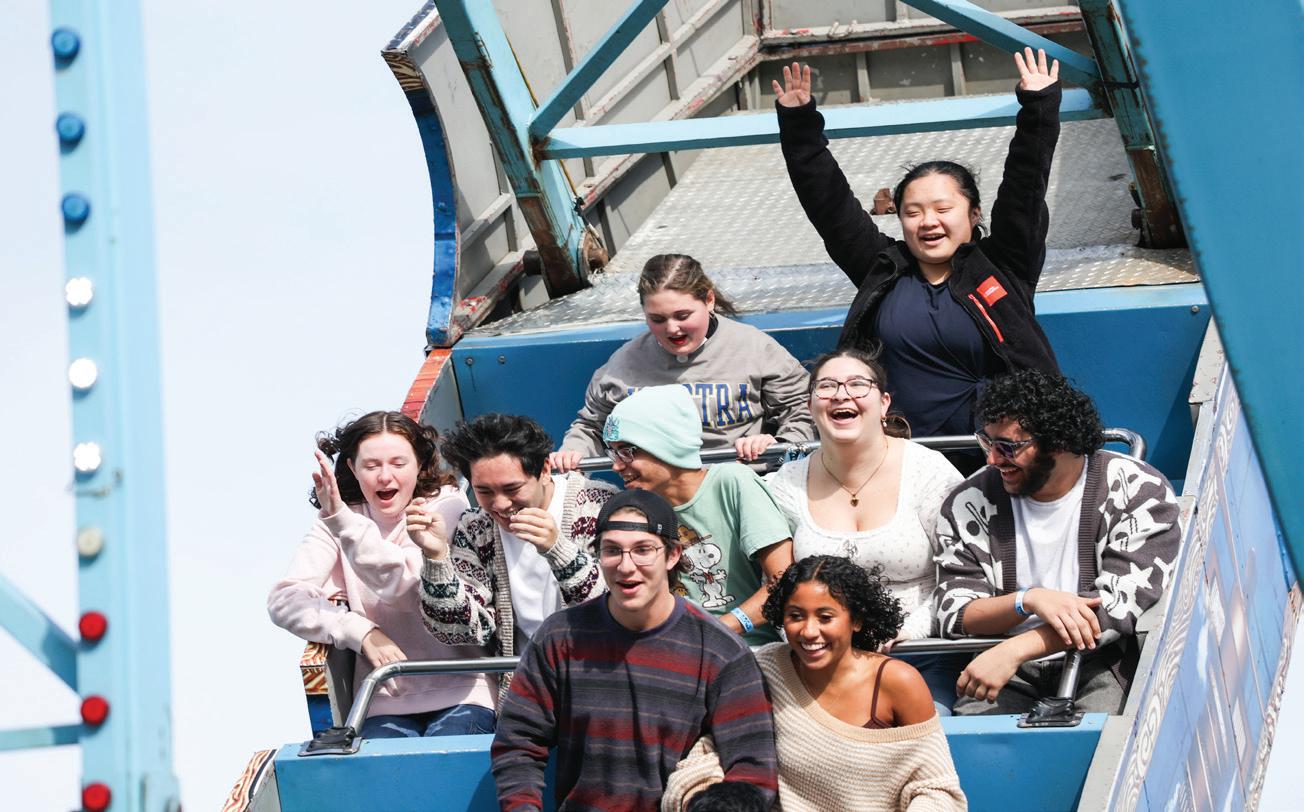
“I think as a freshman, this is a really good opportunity to get to explore the sororities and fraternities,” said Meera Kanaan, a freshman pre-medical studies major. “This is a fun, social event where you can get to see the different groups and socialize with members from them.”
The interactive exhibits provided a unique and welcoming environment for students and family alike to engage with Hofstra’s Greek life.
“I know we didn’t win, but at the end of the day I feel like we did such a great job,” said Owen Smith, a sophomore filmmaking major and member of Phi Kappa Theta.
Another annual highlight of
Fall Fest is Hofstra’s Pride Court Showcase – a celebration of student leaders who have contributed greatly to Hofstra’s student organizations and student life – as well as the crowning of the Pride Court Royalty.
This year’s Pride Court crowned the following student leaders:
Duhan Lee, a senior early childhood education major.
Saskia Laurie, a senior speechlanguage-hearing science and dance double major.
Ally DeMarco, a senior early childhood education major.
Kyle Loeber, a senior business management major.
“It was a full circle moment being Xavier Bell’s backup dancer for his Pride Court Showcase [in 2023] and being able to show my leadership now was a great experience,” said Laurie.
This year’s emcee, Dina Mass-

ery, noted that this is her favorite part of the event.
“I love crowning Pride Court Royalty,” Massery said, a Hofstra 2010 graduate and five time Fall Fest emcee. “It’s really cool to get to interview the students for a second, [and] everyone gets their moment on the [microphone], which I really love.”
Students got to experience live performances from Hello Brooklyn, a New York based cover band that has been performing for Hofstra’s Fall Fest for the past three years, as well as Hofstra’s premier dance team transcenDANCE.
“We love performing here, it’s so much fun every year,” said Karl Markgraf, guitarist for Hello Brooklyn.
Following the crowning of the Pride Court came an incredible performance from this year’s headliner, Big Sean.
“I [want to] see what he performs here at a college level … his music is very early 2000’s so I [want to] see how [everyone] reacts to it,” said Farhan Alam, a senior journalism major.
Known for his debut album, “Finally Famous,” as well as various collaborations with artists such as Kanye West, Drake and Jhene Aiko, Big Sean brought an electric and energetic performance that left an impression on many students.
After Big Sean’s grand performance, students ended the night off watching fireworks light up the sky, marking the end of Hofstra’s 2025 Fall Fest.

Lynda Barry highlights differences between creativity and artistic ability
By Katelyn Buchalter STAFF WRITER
Author and cartoonist Lynda Barry visited Hofstra University on Wednesday, Oct. 22, and Thursday, Oct. 23, to dive into the creative mind and how it arises in everyday life. Along with several workshops given in the Axinn Library, Barry also connected with students and faculty through an immersive lecture in the Helene Fortunoff Theatre at Monroe Lecture Center.
Barry has published several notable works over her career including, “One Hundred Demons,” “Syllabus,” “What It Is,” “Cruddy” and many others. She said she sees her workshops as a way to inspire people to connect with themselves.
“What I want people to be able to do when our workshop is over is to have the urge to show someone else how to do what we did in our class,” Barry said. “There is something about the experience of drawing in this way that makes us want to give it to other people. It’s kind of like a really good joke that you hear and then want to tell someone else.”
Many of her beliefs center around the differences between artistic ability and creativity. Barry highlighted that being creative does not mean being great at something.
“People give up on drawing at about the age of eight or nine,” Barry said. “Often it’s when they are trying to draw in a realistic way. The thing they are drawing doesn’t look like the thing they are trying to draw, like a nose or hands. This is why I love teaching people about drawing comics because comics rely on simple lines that anyone can do.”
Part of Barry’s view is how creativity and drawing should be interwoven with many different areas of academic studies, part of the reason she brought her lecture to Hofstra.
“Drawing in a simple comics style can also bring about serious insight, and my work with graduate students in different fields has convinced me
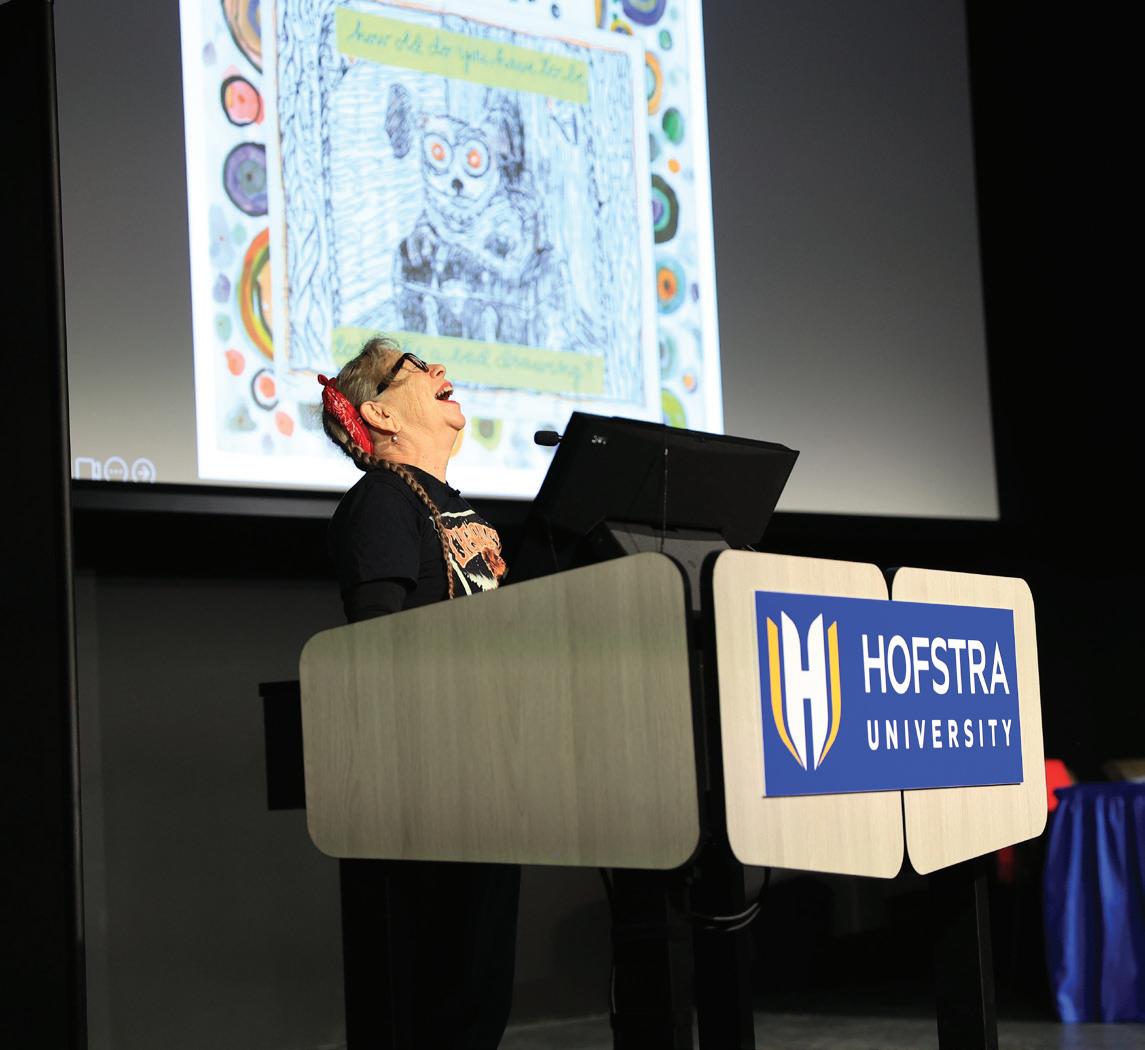
that the comics style of drawing has enormous potential in any academic research,” Barry said. “If creative thinking is about setting the conditions for insight and discovery, drawing is a very simple and direct way to get you there.”
Her lectures included comics she’s drawn, videos that engage her ideas and ways she has connected drawing and comics into the lives of her students.
“I found her syllabus and lecture really inspiring,” said freshmen accounting major Isabella Dempsey. “It was really cool to learn from someone that had a different perspective of life from me, as someone who doesn’t really have much of a creative side. Being able to see and talk to someone that does and who has no hesitation or second thoughts about it really kind of just changed my perspective on a lot of the ways I look at life.”
Barry’s lecture was not about being taught. She said she believes everyone already has the skills to be creative, it’s about how to access it and find pride with it.
“What I love to do is to walk people back into drawing as something other than pleasing or not pleasing,” Barry explained. “For me it is an unsuspected way of thinking, of setting the conditions for insight and dis-
covery. A drawing doesn’t have to look beautiful to be able to do this, in the same way your liver doesn’t have to be cute to keep you alive. This kind of drawing is very much like my liver. It may not be beautiful, but it is absolutely vital.”
The humorous and comfortable environment that Barry established during her lectures allowed students to resonate more personally.
“If something doesn’t go exactly how she planned it, like her books, she finds a way to go around it or find something else that’s inspiring,” said freshman creative writing major Jen Jen Dayton. “If I’m stuck in a creative front she recommends going about it in a different way, ‘take a break,’ as she says, ‘have a decoy novel.’ She even said that she wrote the book that I just bought with a brush and so I think that’s really inspiring.”
The workshops and lectures covered different perspectives and understandings but cemented the idea that everyone is creative.
“There is something about doing this kind of work with other people that makes all of the difference,” Barry said. “And the exercises I teach are very easy to do with other people because they are hilarious.”
Hofstra students, on-campus organizations support breast cancer awareness at Jones Beach walk
By Joe Orovitz MULTIMEDIA EDITOR
It is hard to find somebody that has not felt the effects of cancer firsthand in some way, shape or form. For some, that battle is personal. For others, their battle is fought by the side of a loved one. This is just as true in the Hofstra University community as it is anywhere else, and some passionate students and staff represented the university by showing their support at one of the largest breast cancer walks in the nation.
For the fourth consecutive year, Hofstra’s Department of Public Safety organized a team for the Making Strides of Long Island walk at Jones Beach State Park. The walk on Sunday, Oct. 19, is part of a series of nationwide Making Strides Against Breast Cancer walks hosted and organized by the American Cancer Society (ACS) and its local chapters.
The Jones Beach walk has been going on for 32 years and is the largest of them all, setting a record with over 81,000 participants at this year’s edition.
“We’ve made it a recurring annual initiative to raise money and walk to support those fighting this disease, which has
impacted so many,” said Jovanni Ortiz, Public Safety director for Community Engagement, Special Projects and Campus Transportation in a statement.
“I think it’s great for students to have the opportunity to connect with Public Safety in a different capacity and join together to support the community.”
The Hofstra team comprised over two dozen students donned in pink, the official color of breast cancer awareness, and, of course, Hofstra gear. Some of the students also invited their families to join the cause with Hofstra’s team.
The team set foot on the 5-mile trek along the scenic and unseasonably warm Jones Beach boardwalk at 8 a.m. sharp. The team had the opportunity to share a strong sense of community not only among themselves, but with the greater Long Island population.
“To see this many survivors, it’s inspiring,” said Luca Dallasta, a sophomore sports media major. “I didn’t expect it to be this enormous event to the extent that this is, which is the whole Long Island community coming together.”
If there is one thing that Dallasta took away from this experience, it is the inspiration he
felt from seeing so many survivors in one place.
“It’s incredible to see the strength in [the survivors], which inspires you to continue what you want to do,” Dallasta said.
The sense of joy, optimism and hope that emanated from survivors filled the atmosphere of the event. Loud ringing of bells – a custom for those who have beat cancer –echoed through the crisp morning air at regular intervals, and people proudly donning pink survivor sashes could be seen in every direction.
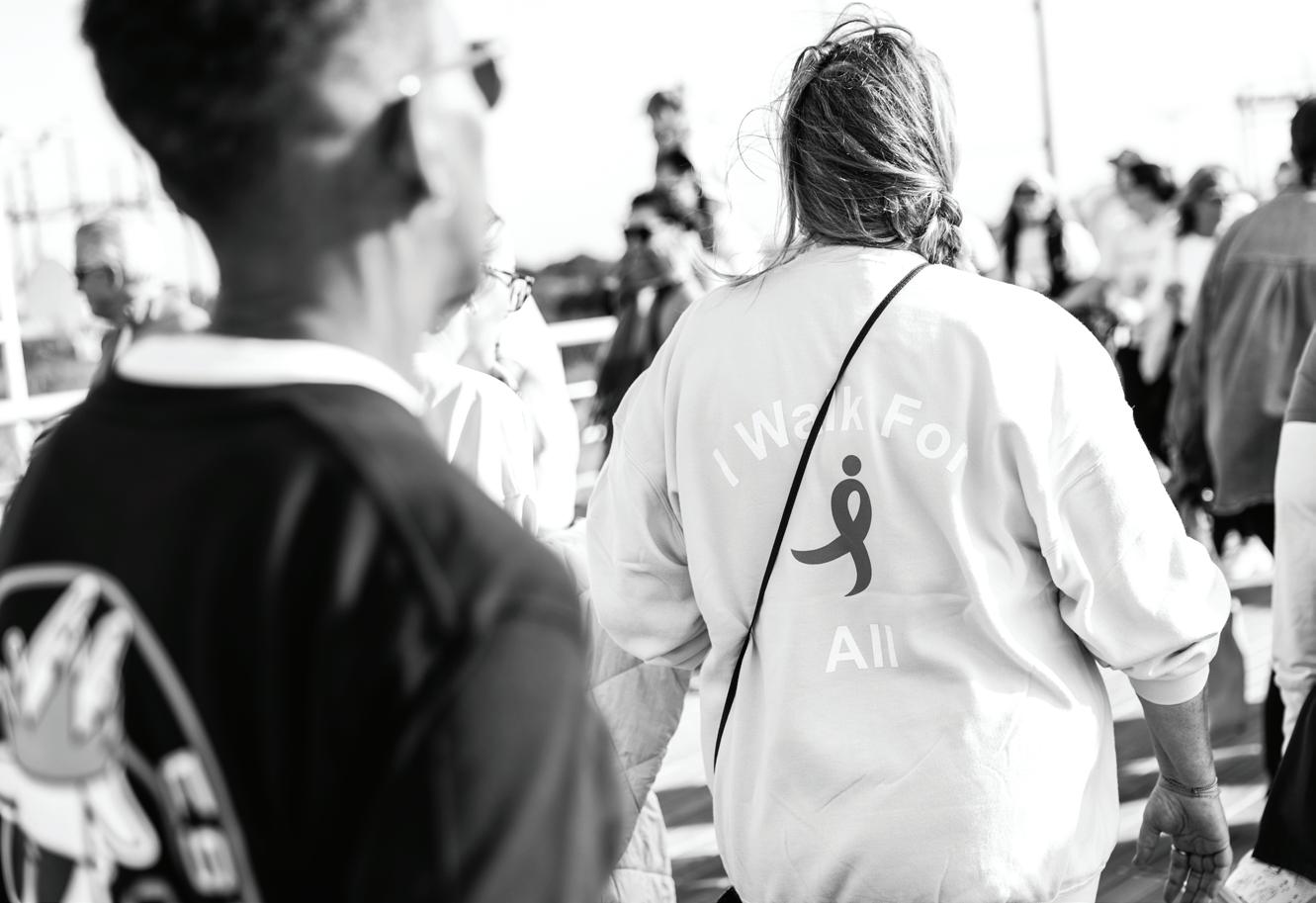
“It means everything to see so many people here to support,” said Jennifer Halpern of Woodbury, New York.
Halpern is a metaplastic breast cancer survivor, a rare form that only affects 1% of people with breast cancer and underwent treatment at Memorial Sloan Kettering’s Uniondale location, which is across the street from Hofstra University’s North Campus.
Halpern emphasized that while it is sad to see that so many people have suffered from breast cancer, it is most importantly a happy event.

“A survivor walks past, and I see them with their shirt … we cheer, and we give each other a high five or a hug,” Halpern said.
Seeing so many victims and survivors is something that also stuck with Pavin Jones, a sophomore filmmaking major.
“It makes you appreciate what you have,” Jones said. “You can really feel the pride out here.”
Both Dallasta and Jones joined the official Hofstra team sanctioned by Public Safety and traveled to the walk via the shuttle bus. Student involvement in the event did not stop at just their group. Campus organizations such as Danceworks and a number of Greek chapters participated in the event as well, separate from the main team.
Hofstra’s impact even extended to the highest level of the event’s organization. Natalie Raimo, executive director of Long Island ACS and organizer of the event, is a Hofstra alum and graduate of the class of 2002.
“Year after year, the community continues to show up and support our cause,” Raimo said.
Raimo’s passion for the cause stems from 15 years of participation in the event and personal experience. One of her closest friends passed away due to breast cancer in 2021, and she has used this experience to increase her advocacy efforts.
“I encourage all of my friends,
my family … everyone to get screened and to get checked, because you just never know,” Raimo said.
The walk that Raimo helped organize was not only meant to spread awareness. A key aspect of the event was that it offered people practical services to assist in one’s cancer journey, from pre-diagnosis to end of treatment. Tents that offered services such as screening scheduling, places to answer questions and other patient resources lined the bike path east of the Field 5 parking lot.
The walk raised a total of $2.45 million, another record for the event. The money will have a tangible impact on the lives of people with cancer, according to Raimo.
“We raise the funds, and the money goes towards research, advocacy efforts and patient services, such as lodging for treatment and transportation,” Raimo said.
Hofstra students, staff and alumni all had the opportunity to see the sheer number of people that cancer affects in the community, and their efforts at the walk contributed to bettering the community in a positive way.
CONTINUED FROM A1
truth,” Poser said. “You have to apply some analytical skills.”
She also emphasized that the use of ChatGPT Edu in the classroom is completely at the discretion of the professor and serves as a learning tool for students. However, some see this offer as not very useful.
“In the classes I’ve had to use [ChatGPT], I feel like I could have done the research myself to complete the assignment with just as much understanding than if I put it in a prompt,” said Annecamie Augustin, sophomore finance major and vice president of Black Student Union.
Poser speaks at town hall cont.
Augustin and others also engaged in a dialogue with Poser about her email in September concerning the shooting of Charlie Kirk at Utah Valley University. Some pointed out how she spoke on the Kirk shooting but not the death of Demartravion “Trey” Reed or other issues, such as Israel’s invasion of Gaza. Poser defended the statement by saying that Kirk’s death happened on a college campus and it had to do with freedom of speech.
“I tried very hard to make that email not about the particular views of Charlie Kirk,” Poser said. “But really about political speech-based violence on campus.”
She also acknowledged that Reed’s death happened on a college campus like Kirk’s did.
Poser stated during the town hall meeting that her speaking up on one issue and not another did not mean she thought one issue was more important than the other. She added that she was not aware of some issues that students brought up. Still, some said they felt that Kirk’s death could have been better addressed. Smith pointed to the Stuart and Nancy Rabinowitz Honors College’s statement on the issue as an example.
“That email was more well thought out and down to earth than what President Poser gave,” Smith said. “I felt a lot more heard from the honors college email addressing the [Kirk] situation than by Poser’s.”

Public Safety Briefs
eventually found the scooter on Oak Street in front of the Netherlands Complex.
On Friday, Oct. 3, 2025, at 8 p.m., three HU students reported to PS that while sitting in the Netherlands parking lot, they observed three unknown persons stealing an electric scooter from a bike rack and leaving the scene westbound on Hempstead Turnpike. The three HU students followed the unknown people, and the scooter was dropped in front of the Sunoco gas station. PS
On Sunday, Oct. 5, 2025, at 5:36 a.m., a hot water pipe burst between the fifth and sixth floors of Nassau Hall, causing flooding and water damage. A work order was submitted to fix the damage to the property.
On Wednesday, Oct. 8, 2025, at 6 p.m., an HU student reported to PS that an unknown person used their dining dollars without permission. An investigation is being conducted into the matter.
On Monday, Oct. 13, 2025, at 2:01 p.m., an HU student reported to PS that around 9:20 a.m., they parked their vehicle by the Science and Innovation Center. Upon their return around 11:15 a.m., the student discovered damage to the driver’s side bumper; police assistance was declined at the time.
On Tuesday, Oct. 14, 2025, at 10 p.m., two unknown males entered Hofstra USA. One of the males climbed onto a table and poured a bucket of water over himself while the other
male recorded it. The two individuals left the building before PS arrived. An investigation is being conducted into the matter.
On Thursday, Oct. 16, 2025, at 10:20 a.m., vehicle one, driven by an HU student, struck two parked vehicles also registered to HU students, causing damage to both cars. Police assistance was declined at the time.
On Thursday, Oct. 16, 2025, at 11:18 a.m., an HU student reported to PS that on Wednesday, Oct. 15, 2025, they parked their vehicle in parking field 2A around 4
p.m. When they returned that same evening around 8 p.m., the student discovered damage to the side mirror; police assistance was declined at the time.
On Friday, Oct. 17, 2025, at 6:54 a.m., the fire alarm in Memorial Hall activated due to dust. The building was unoccupied at the time. PS responded. The situation was corrected, and the fire alarm was reset.
By Hannah Mudry FEATURES EDITOR
Elena DiStefano graduated from Hofstra University in 2023 with a dream – a dream that soon after her graduation would become a reality.
“I actually had the idea on campus. I specifically remember driving with my roommate and I was wearing a claw clip,” DiStefano said. “I just wanted my claw clip to bend when I leaned back, and it didn’t. Then, it just kept happening. I got fed up with my claw clip.”
After noticing how uncomfortable a claw clip left her feeling while in bed, at the gym or in the car, DiStefano searched for a flexible, bendable claw clip and found that none existed. In the summer of 2022, she sought out a way to create her own.
“The Cozy Clip is the first flexible claw clip. It’s designed for comfort and peace of mind. Whether you’re driving, lounging or working out, traditional claw clips are very uncomfortable,” DiStefano said. “Whenever you are wearing it and you lean your head back on something, it flexes and squishes, but it also is able to stay in your hair.”
The first prototypes of the Cozy Clip were made at Hofstra. DiStefano was originally going
By Juliana Calcao
SPECIAL TO THE CHRONICLE
Azure, Hofstra University’s Korean pop (K-pop) dance troupe, held its yearly audition in the Hofstra Fitness Center on Sept. 14. Eight students showed up to audition, all of whom were brought into the studio in randomized duos.
“We do covers of different choreography and then perform on campus,” said Jupiter Housen, senior forensic science major and vice president of Azure. “We also hold events to do with K-pop in general. Overall, Azure lets people have a safe space to enjoy K-pop and the fan culture that surrounds it.”
Each dancer at the audition was evaluated on their choreographic knowledge of two songs: “Lemon
FEATURES
Alumni Feature: Elena DiStefano
to craft a bendable hair clip using a broken, hard-plastic claw clip, and each claw would have a hinge so the device could flatten. This first prototype resembled more of a flat clip than a claw clip.
From there, DiStefano began 3D printing designs using the ideaHUb’s Maker Space in the Leo A. Guthart Hall for Innovation and Discovery.
She took part in the Lion’s Den competition in November 2022, Hofstra’s version of Shark Tank, where business students can pitch products for others to invest in. DiStefano won third place with her idea.
“[Third place] gave me the acknowledgement that the idea [was] something worth pursuing,” DiStefano said. “Someone had said to me, ‘You should do the Digital Remedy Venture [Challenge].’ I spent months and months preparing. I’m not even a competitive person or anything, but I really wanted the first-place prize because that was the next level and really would jumpstart my business.”
DiStefano took home the first-place prize from the Digital Remedy Venture Challenge, another one of Hofstra’s Shark Tank-style programs. The competition provided her with mentors who helped her start her business and who still guide her today. She also won the $45,000 prize,
allowing her to start investing in her product.
DiStefano’s company has taken off since that competition, with Cozy Clip having over 50 million views across every social media platform. Additionally, Distefano has auditioned for Shark Tank twice, and her product has sold out for every launch.
“I launched my 3D printed versions in January of this year. I was hand-making them [before],” DiStefano said. “I had to sell these limited batches of such a small amount, and then I have videos that are getting millions of views. People are like, ‘Oh, it sold out in under a minute. Is this real?’ And I’m like, ‘Yes, it’s real. I’m sorry, but I’m just, like, trying to make it all myself.’”
DiStefano said her favorite part of the process has been the originality of the brand. Cozy Clip prioritizes its customers because DiStefano wants everyone who visits her site to have a great experience. Cozy Clip is a tool to help people feel comfortable because a hard-plastic claw clip can be dangerous in damaging situations, like car accidents.
DiStefano credits Hofstra’s business programs for her success. The school provided ways for her to prepare for Shark Tank auditions and company investments.
“I feel like [the Digital Remedy
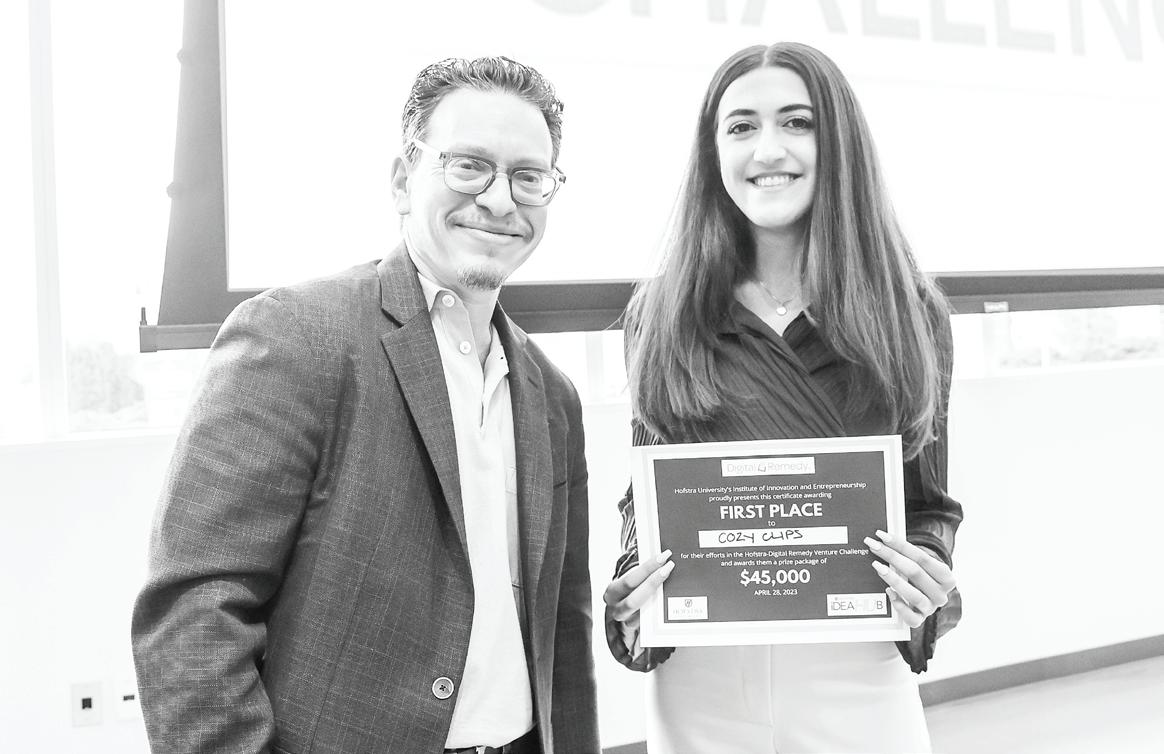
Venture Challenge] set me up for success, in a way, because I was able to practice my public speaking skills, which is not my forte whatsoever,” DiStefano said. “[Auditioning for Shark Tank] made me feel like I was around other people who were similar to me … I think it was a really great experience, and I’m just excited to do it again. You know, I have high hopes for the next time.”
DiStefano takes a front row seat in running her company by managing all her social media accounts, even as sales boomed. She graduated from Hofstra with a degree in public relations and a desire to become a social media manager. Today, she has reached that goal as Cozy Clip remains active on platforms like Instagram and TikTok.
“It was really crazy when I first went viral,” DiStefano said. “I
Club Feature: Azure
Drop” by ATEEZ and “The Chase” by Hearts2Hearts. Both songs feature intricate footwork and a fast pace.
ATEEZ, a South Korean boy group, debuted in 2018, and Hearts2Hearts, a South Korean girl group, debuted in early 2025. Boy and girl groups differ stylistically from each other, a quality Azure celebrates by presenting a mixture of the two stylistic qualities when they perform on campus.
Each dancer has their own story about what it means to get on stage and perform.
“The culture around K-pop is colorful, and so it has made my world more colorful. I started by getting into BTS, and that has really gotten me out of my shell and given me the ability to branch
out and get out of my house. It’s all about culture and community,” said Chantel Bilson, an auditionee and sophomore sociology and psychology double major.
Housen feels that having a K-pop group at Hofstra is important because there are many other representative cultural groups on campus. Azure is all about celebrating a style of dance and culture that is oftentimes ignored or not represented. The organization is also working on a subsection for fans of K-pop who are not dancers in order to be more inclusive.
Being a fan of K-pop can sometimes come with some scrutiny, and outsiders may attach stereotypes to its supporters due to its origin of South Korea. This was a lesson that Azure Presi-
dent Miché Hines learned from the start. When Azure formed in 2023, they performed at Hofstra’s annual Drop of Drag performance. People recognized them as a multicultural group, but the lack of Asian dancers in a K-pop cover group was a problem Azure initially faced.
“In the [U.S.], K-pop dance clubs and founding members are usually thanks to Black people and our influence, especially hip hop,” Hines said.
Every individual on the team has a range of technical skills and backgrounds. This is an aspect Hines wanted to emphasize.
“We don’t have the years and hours of training that [the Hofstra dance team] has, but we try to make our performances fun for those used to Western dance
was so happy. I could not get off my phone. I couldn’t stop reading the comments.”
DiStefano remembers viewers liking her brand – all the comments were fairly positive and encouraged her to release the Cozy Clip.
“I definitely went viral before I was totally ready, and that was a challenge,” DiStefano said. Currently, Cozy Clip only ships to the United States, which has posed a problem as her product has garnered attention worldwide. However, DiStefano hopes to ship internationally soon. The company is also preparing to launch more colors and sizes of the clip.
“Remember,” DiStefano said. “Cozy Clip is the original.”
styles. It’s a very different world. There are also different expectations,” Hines said.
Maxina Ingersol, a dancer at the audition and freshman broadcast journalism major, found her way into the studio because she loves both K-pop and dancing, so she wanted to combine both interests. Ingersol has been dancing since the beginning of middle school. She also has indulged in learning K-pop dances on her own time for seven years.
Interest and passion guided the selection process during and after auditions. At the end, Azure’s executive board members welcomed a new batch of K-pop lovers into the team. This new dance crew will help Azure define K-pop at Hofstra, echoing those who have come before them.
FEATURES
This Hofstra Life: Richie Castronova
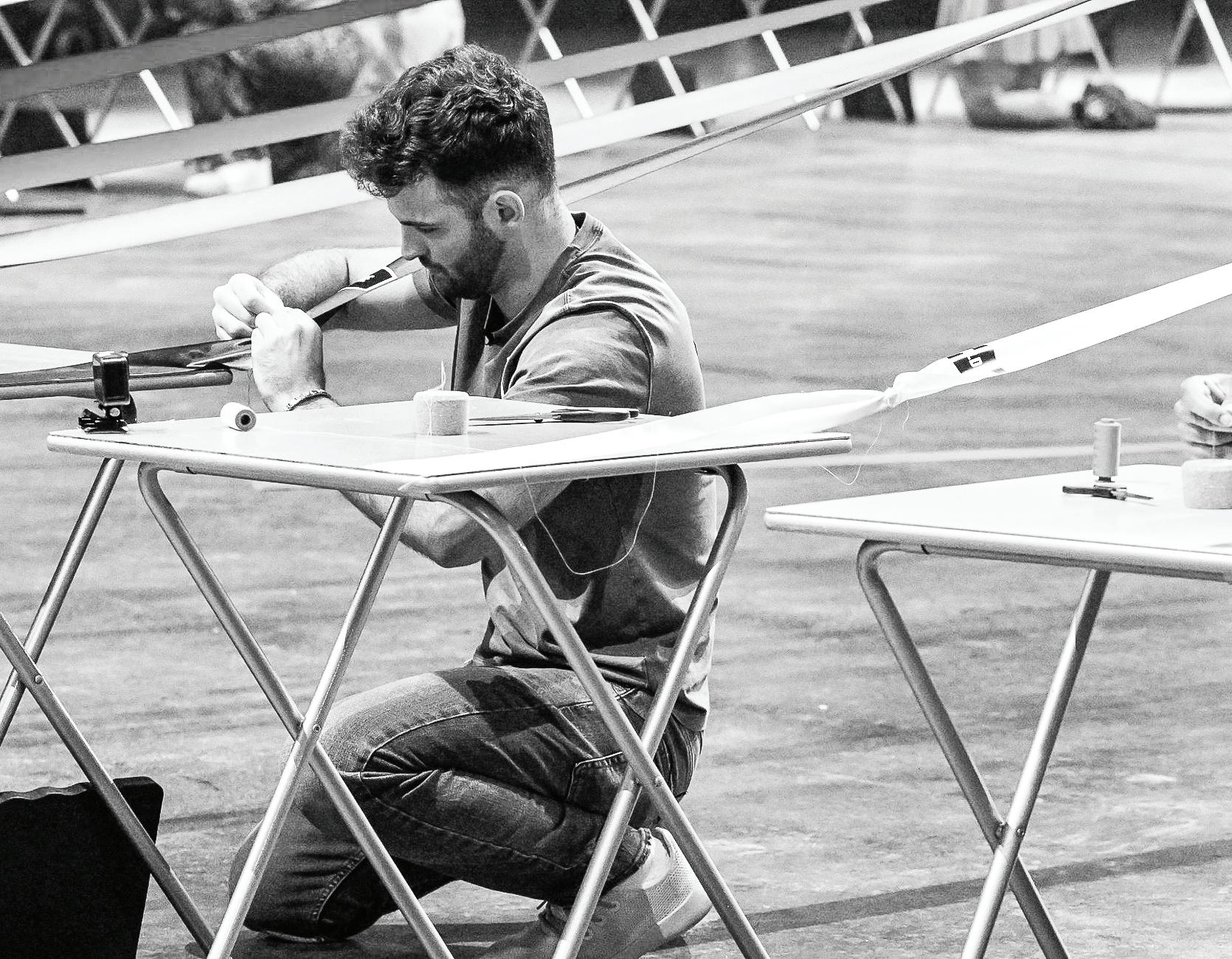
CONTINUED FROM A1
Castronova grew up in Bayshore, Long Island, but recently moved to nearby Great River.
“I love Long Island – born and raised here,” Castronova said.
When it came time to choose a college, staying close to home just felt right for him.
“I knew I didn’t want to be too far from home, but far enough that I could have my own life,” Castronova said. “Hofstra [University] was perfect – close enough if I needed to be home.”
At Hofstra, Castronova is a television and business major with a minor in public relations, but that combination was not always part of the plan. In fact, it took him several tries to find his academic home, originally enrolling as a filmmaking major.
“I wasn’t really sure if film was something that I really wanted to pursue,” Castronova said. “But since the school offered a major in it, I figured, why not pursue it?”
And while he found himself enjoying the buzz of show life, something still was not right, so he changed his major to video, television and film. The television (TV) world quickly became his passion, and he knew he was on the right track. With this solidified, he explored opportunities in the field; little did he know, his passion for TV could go even further.
Like many other Hofstra students, Castronova had heard whisperings about the University’s Hofstra LA program, a semester-long communica-
said. “I’ve done a lot of crewing before – camera operation, assistant directing – but producing is new to me. It’s out of my comfort zone, and that’s what I love about it.”
And when he is not behind the camera, he is in front of it as a recurring anchor of Newsbreak on Thursday Nite Live.
“Thursday Nite Live has always been something that fills my cup,” Castronova said. “It’s my regeneration, my refuel that reminds me this is what I love to do.”
tions-based experience on the West Coast. When his friend Arlette Peralta mentioned it, he jumped at the opportunity.
“[Los Angeles] was always a thought in the back of my head,” Castronova said. “I’ve always loved the idea of going somewhere sunny. It’s [nice] year-round, you know, it’s sunny, shiny LA; it’s ‘La La Land.’” That semester changed everything.
Castronova interned at Silent House Productions, the creative team behind the SAG Awards, Coachella and the Backstreet Boys’ Las Vegas residency. It was there that he began to see a career beyond studio production.
“Going to LA opened my eyes to what the real world looks like in communications,” Castronova said. “Learning about [public relations], learning about marketing, knowing there’s a social position I could work in – I had no idea that was a possibility for me.”
By the time he returned to New York, he knew he had to make a change. He made his final major switch to television business to make room for a minor in public relations.
“Honestly, it felt like fate,” he said. “It felt like the perfect and right decision to make.”
Back at Hofstra, Castronova has a busy schedule, involving himself in as many extracurriculars as possible.
He recently began a position as a package producer for Hofstra Today, where he manages story sourcing, shoots and edits.
“It’s super fresh to me,” he
know that I’m not straight?’ My fraternity was super accepting. I never even told anyone individually – it kind of just became common knowledge.”
Then, when asked about his favorite memory associated with Greek life, he grinned.
He competed alongside his sister, Gianna Castronova.
“We filmed in London for three weeks. Afterwards, my sister and I flew to Rome before coming home. We really abused that travel voucher,” Castronova said, laughing.
Castronova is also a resident assistant, which has allowed him to be more involved all over campus.
“Sophomore year, I was living off campus, and it wasn’t the greatest environment for me,” Castronova said. “So having the opportunity to completely shift that and change to something that can give me responsibility, a sense of belonging [and] a sense for people relying on me – that excites me.”
That kind of balance between leadership and creativity defines Castronova’s college experience.
“Juggling things is hard,” Castronova admitted, “but when you have a good support system – friends, family, fun experiences – it makes it all worth it.”
Part of that support system here at Hofstra came through Hofstra’s Greek community. Castronova joined both Zeta Phi Eta, the professional communications fraternity, and Phi Kappa Theta, a social fraternity.
“Zeta Phi Eta gave me a community of people who are equally as creatively driven,” Castronova said. “Being able to grow off creative minds is huge.”
His involvement in Greek life also shaped his understanding of acceptance and himself.
“Coming into college, it’s always difficult to let go of your past,” he said, getting vulnerable. “Realizing my sexuality was hard, but understanding that it was okay to be myself in a community of people that are fully accepting of me was great.”
Before admitting that he was overthinking, Castronova said, “My biggest concern was kind of like, ‘how would the people in my life treat me now that they
“The lovely ladies of Delta Phi Epsilon put on an event every single year called Hofstra’s Hottest Man,” Castronova said. “It’s a competition that supports their philanthropy for women’s heart health. A bunch of men from different fraternities compete in a pageant – the end goal is to raise funds for a great cause and have a good time doing it.”
“The fun, interactive element is that you get to vote on Hofstra’s Hottest Man,” Castronova said. “I was in the running for that freshman year – and I did, in fact, win. It was a fun experience doing that with my friends and getting that title.”
Outside of Hofstra, Castronova recently made his national television debut as a contestant on FOX’s “99 to Beat.”
“‘99 to Beat’ is a competition show of a hundred people all competing to be the last one standing for a million dollars,” Castronova explained. “The motto is ‘don’t finish last.’”
The show, filmed in London mixes absurd physical challenges with psychological twists.
“They had us do insane things like defrosting a whistle in a block of ice, stuffing duct tape in a lunchbox [and] blindfolded musical challenges. It was mayhem, but hilarious,” Castronova said.
Despite the chaos of the competition, Castronova said “99 to Beat” host Ken Jeong’s kindness stood out.
“[Jeong] is the nicest guy ever,” Castronova said. “He’s generous, thoughtful and selfless. He really cares about the show and everyone on it.”
For Castronova, participating in the show was more than just a TV appearance. It was a lesson in teamwork, resilience and not taking himself too seriously.
As graduation approaches, Castronova is thinking about his next chapter.
“After college, I would love to work some sort of pre-production development job, or with a company that does live events like Silent House or doing social media for a bigger company,” Castronova said. “Whatever I could be presented with, I can take and run with.”
But beyond titles and internships, he carries a broader philosophy.
“Fear is the killer of creativity and the killer of progress,” Castronova said. “You need to fight it deep down because what comes after is growth.”
It is advice he truly believes in. And it is exactly the kind of grounded optimism that defines him as a person.
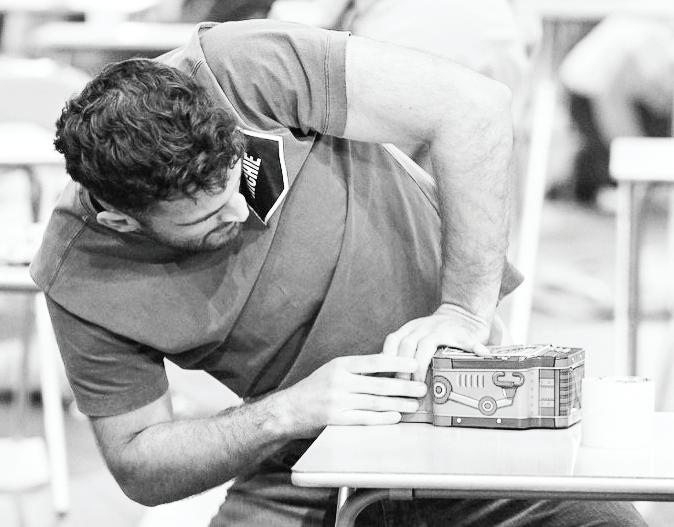
M AN ON THE U NISPAN
What are you going to be for Halloween?
By Denivia Rivera and Joe Orovitz FEATURES EDITOR AND MULTIMEDIA EDITOR
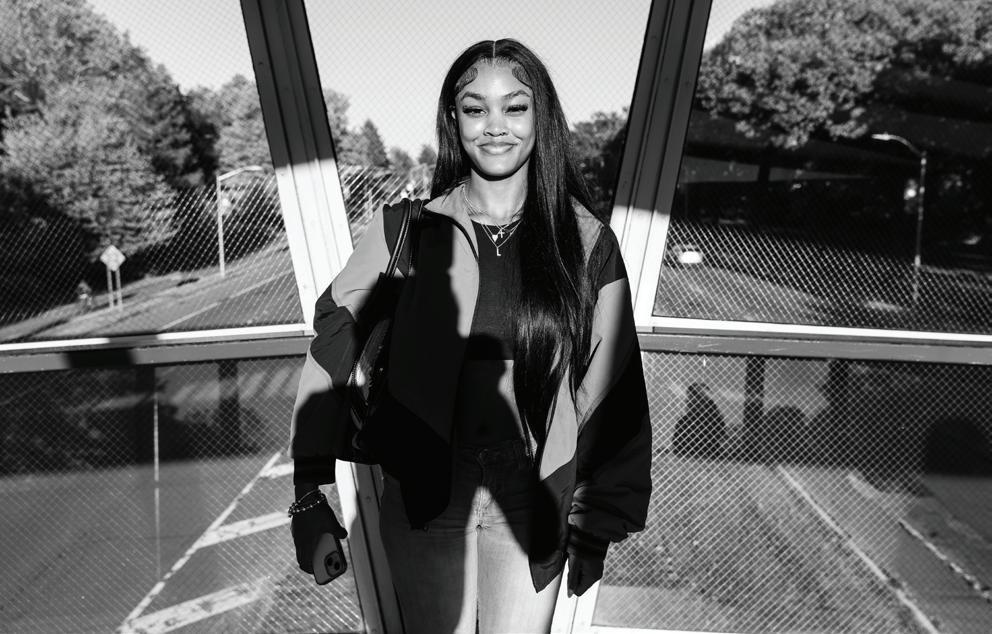
“Cleopatra.”
-

O verheard @ h O fstra
“Do you think Labubus witnessed the Salem witch trials so that’s why they smile like that?”
“There’s so many catboys in here!”
“Your haircut gives very Italian.”

-
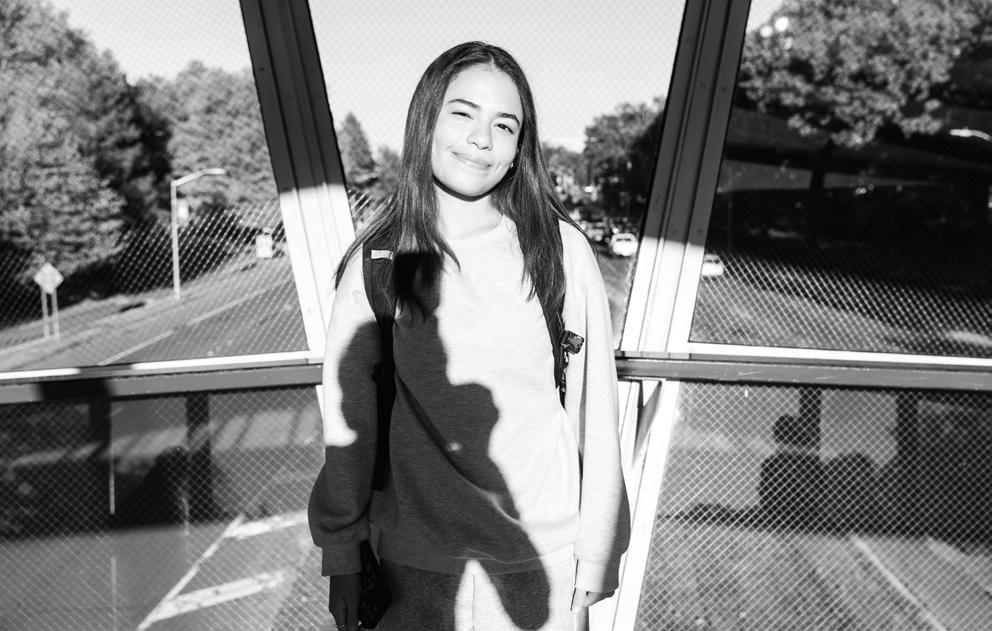
“I wish I could just be a little fairy going on her fairy way.”
“Can an oyster drown?”
“I was raised by women. My mom is not gay I just don’t have a dad.”
“Is Taylor Swift Juice WRLD for girls?”
“No I haven’t been going to the gym.”
“Next time just lie.”
“Why would I have regular Goldfish when there’s flavor blasted Goldfish? Regular Goldfish is for babies.”
By Ryan Monke MANAGING EDITOR
In Robert Plath’s classrooms, students do not write with a pen, pencil or keyboard; they write with an ice pick. It is a riff off novelist Franz Kafka’s famous quote, arguing that a good book must be “the axe for the frozen sea within us.” In the classroom, Kafka’s axe is scaled down to a mere ice pick that students wield to chip away at that which is buried deep down inside them. If this seems shockingly deep for a writing studies class, maybe it is. But it is part of Plath’s teaching philosophy at Hofstra University that prioritizes honesty, vulnerability and expression over stiflingly academic and mundane writing.
Plath, who was born in Brooklyn, New York, and later moved to Long Island, began writing at a young age. In a spiral notebook, Plath would collect quotes from songs and books that he came across. These quotes triggered ideas for poems and stories as he began writing; this notebook of quotes also guided him through his life.
“It was like advice on how to live,” Plath said. “I would be thinking about what I was going through, and then I would think of a quote that I had written down.”
Plath’s interest in writing grew in high school as he continued to read and write. In college, Plath took a nonlinear path, initially pursuing psychology before taking anthropology and archeology classes and ultimately finding his way back to English.
“It felt like English and reading and writing was like … breathing,” Plath said. “It wasn’t like I was working, so it felt good.”
After attaining his undergraduate degree from Stony Brook University, Plath was drawn to Brooklyn College by a program taught by Allen Ginsberg, one of Plath’s early literary influences. Ginsberg, a pioneer of the Beat Generation of poetry, was most known for his famous
This Hofstra Life: Robert Plath

poem “Howl,” in which Ginsberg grieved the intellectual and creative destruction caused by conformity and repression.
Studying under Ginsberg’s mentorship, Plath gained an appreciation for raw and authentic writing.
“
“They almost made it sound like writing is an exorcism, like getting all the demons out,” Plath said.
While drowsy-eyed students who are unfamiliar with Plath’s teaching style might enter their first writing composition class with the expectation of monot-
By thinking about the last few hours of the world, students are encouraged to live in the moment and evaluate what truly matters to them.
… Be honest – in your life and your art … especially in writing.”
Shortly after Plath graduated from Brooklyn College, Ginsberg died. However, the impacts of his Beat-Generation style remained present in Plath’s writing philosophy as he transitioned into teaching.
In 1999, a year after beginning his teaching career at Suffolk County Community College, Plath was hired at Hofstra. In his time at Hofstra, Plath has primarily taught introductory writing courses, such as the writing composition classes that every student is required to take. In addition to the foundational writing composition courses, Plath has taught classes at Hofstra on business writing and resistance writing, which focuses on social injustices and protest.
onous discussions of properly formatting an essay or using the correct type of punctuation, they would soon be shocked when met with their first writing assignment.
Rather than demanding polished writing, Plath aims to get students to write from the soul. One of his most popular writing prompts is a hypothetical that encourages students to consider what they would do if they only had eight hours left on Earth. While Plath has been using this prompt since he started teaching, he feels like it has only grown more relevant since 2020.
“After the pandemic, I think people felt like that was some kind of possibility all of a sudden,” Plath said.
cess of his classes. The parallel between music and poetry is not lost on Plath.
“Some [songs] feel more like poems than poems that I’ve seen,” Plath said.
Plath recounted a time when he shared Mitski’s NPR Tiny Desk Concert in class. The agony conveyed in the video seemed to resonate with students.
“She screams into the pickups of the guitar … It’s like she’s howling,” Plath said. “They all seem to feel that desperation and that honesty.”
Even when class sessions are spent quietly writing, Plath puts on a playlist of music selected by students. The background music creates a nearly meditative atmosphere.
Other prompts in Plath’s classes ask students to write a hypothetical eulogy they would want read at their own funeral. Or an “unsent letter,” something the students would be apprehensive to actually send, offering students the opportunity to get anger or regret off their chest. Plath’s classes include a lot of unconventional writing exercises, like a prompt based on a Buddhist saying, encouraging students to create a list of things they would want to “empty their boat” of.
Even in his business writing class, Plath takes an unconventional teaching approach. Instead of dull corporate writing, students are tasked with assignments like creating an official press release for an end-of-theworld party.
Recently, Plath has embraced a more multimedia approach to teaching. After previous students had recommended he listen to musical artists like Frank Ocean and Mitski, he began incorporating music into the creative pro-
The philosophies that inform Plath’s classes are echoed through his own published works. Since 2003, Plath estimates he has published roughly two dozen books. One of Plath’s most notable books is based on the same exercises he uses in his classes. The book, made up of 35 chapters of writing prompts and commentary, is titled “An Ax For The Frozen Sea,” dedicated to the Kafka quote that so much of Plath’s philosophy revolves around.
Every student in one of Plath’s classes is encouraged to confront the notion that what is more uncomfortable is often left unaddressed. This task is easier for some students than others, with the fear of judgment restraining some students from speaking up. While Plath does all he can to create an honest and safe environment, it can be intimidating to get so vulnerable. Plath will not force students to stand in front of the class if they do not feel comfortable. But even to those silent students, he encourages them to take the ice pick to the frozen sea within them.
One message he wishes students will take away from his classes is “to be honest – in your life and your art … especially in writing.”
Another Hofstra University Fall Fest in the books! Carnival rides, student-built displays and rockin’ performances lined the schedule for one of Hofstra’s annual traditions on Saturday, Oct. 18. Pride Expo kicked off the unseasonably warm day with the university’s Greek organizations building themed displays that were later judged. They were followed shortly afterward by the carnival rides making their first go-arounds. The student performance by transcenDANCE, returning band Hello Brooklyn and the headlining performance by rapper Big Sean rounded off the main events, and the night ended with a colorful display of fireworks – another fantastic Fall Fest!



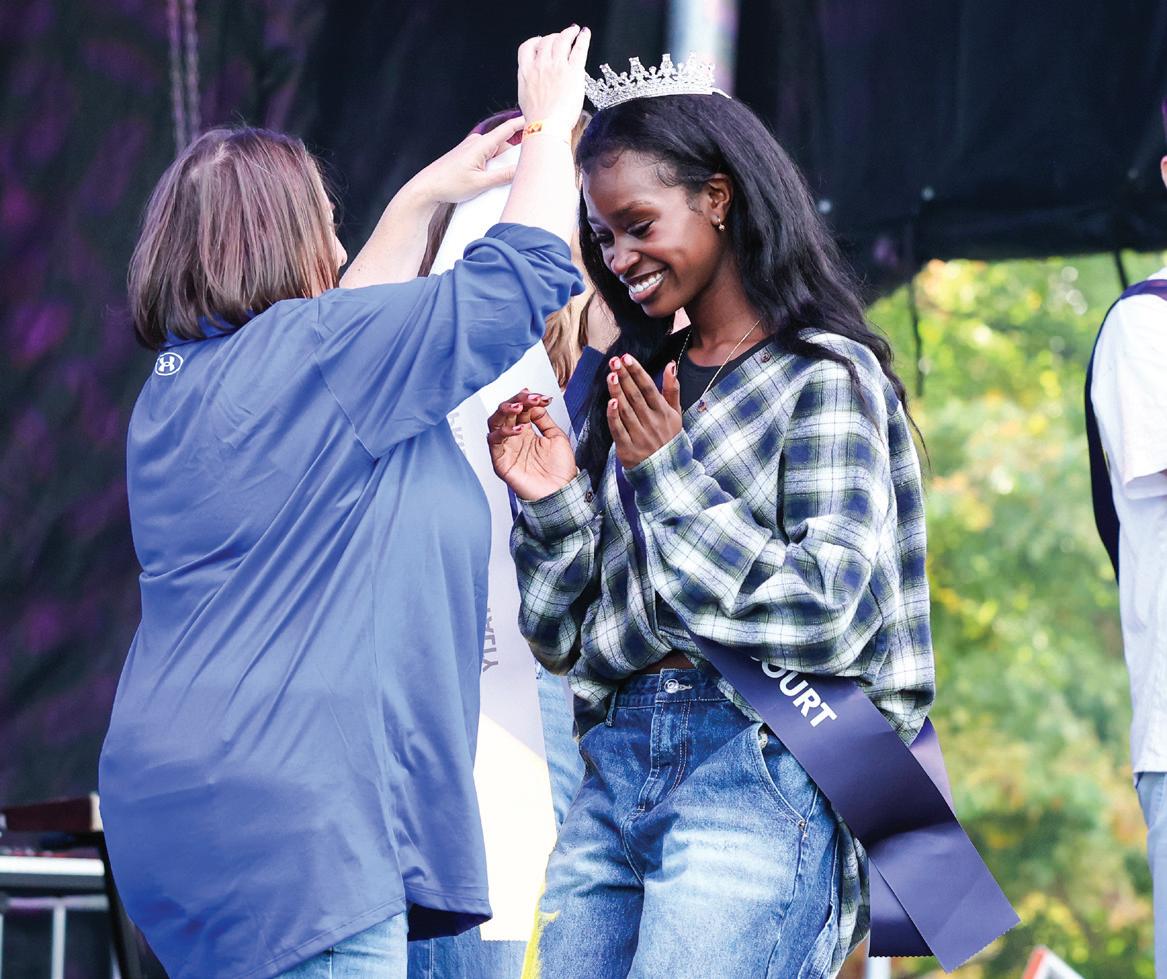

FALL FEST

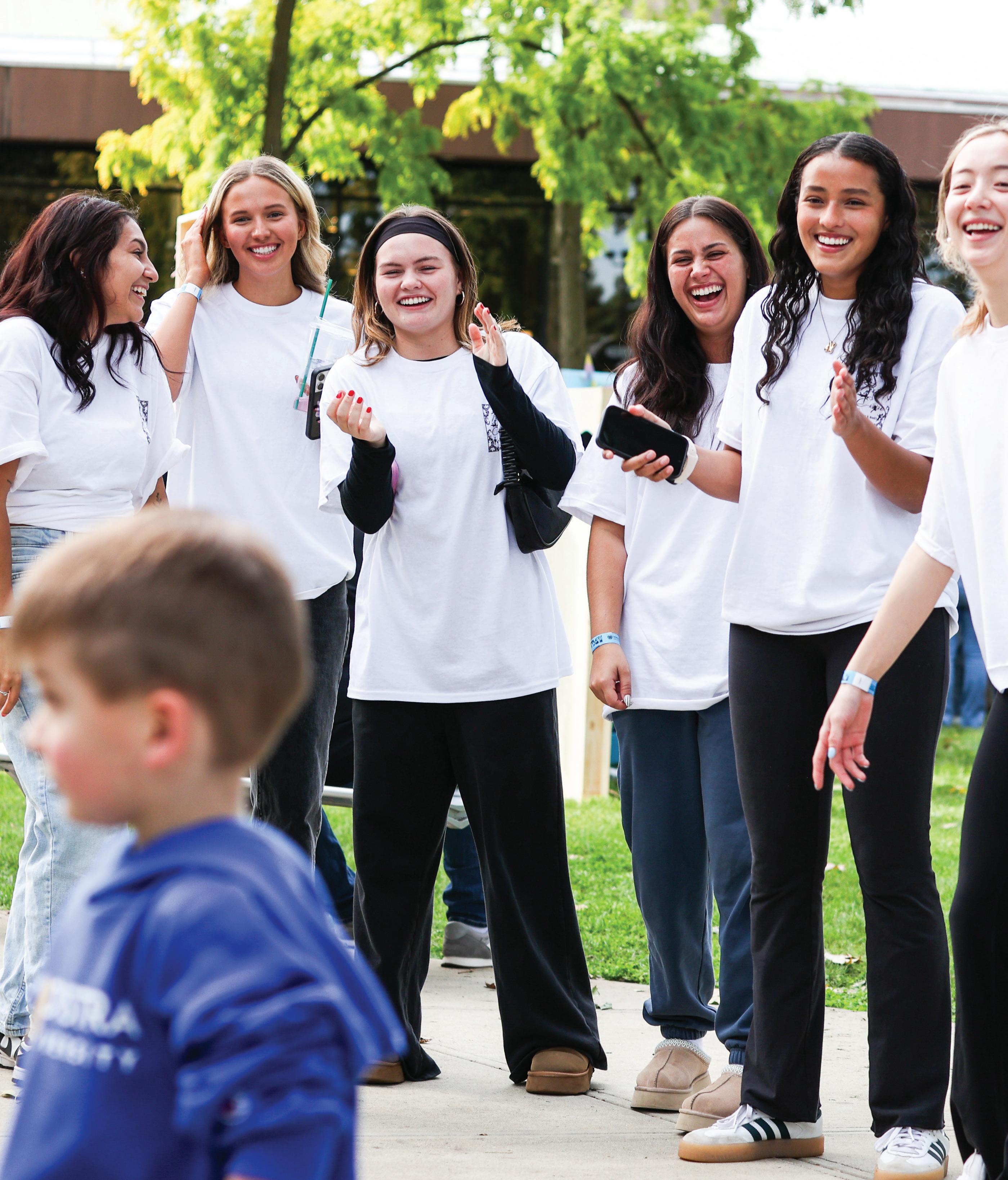
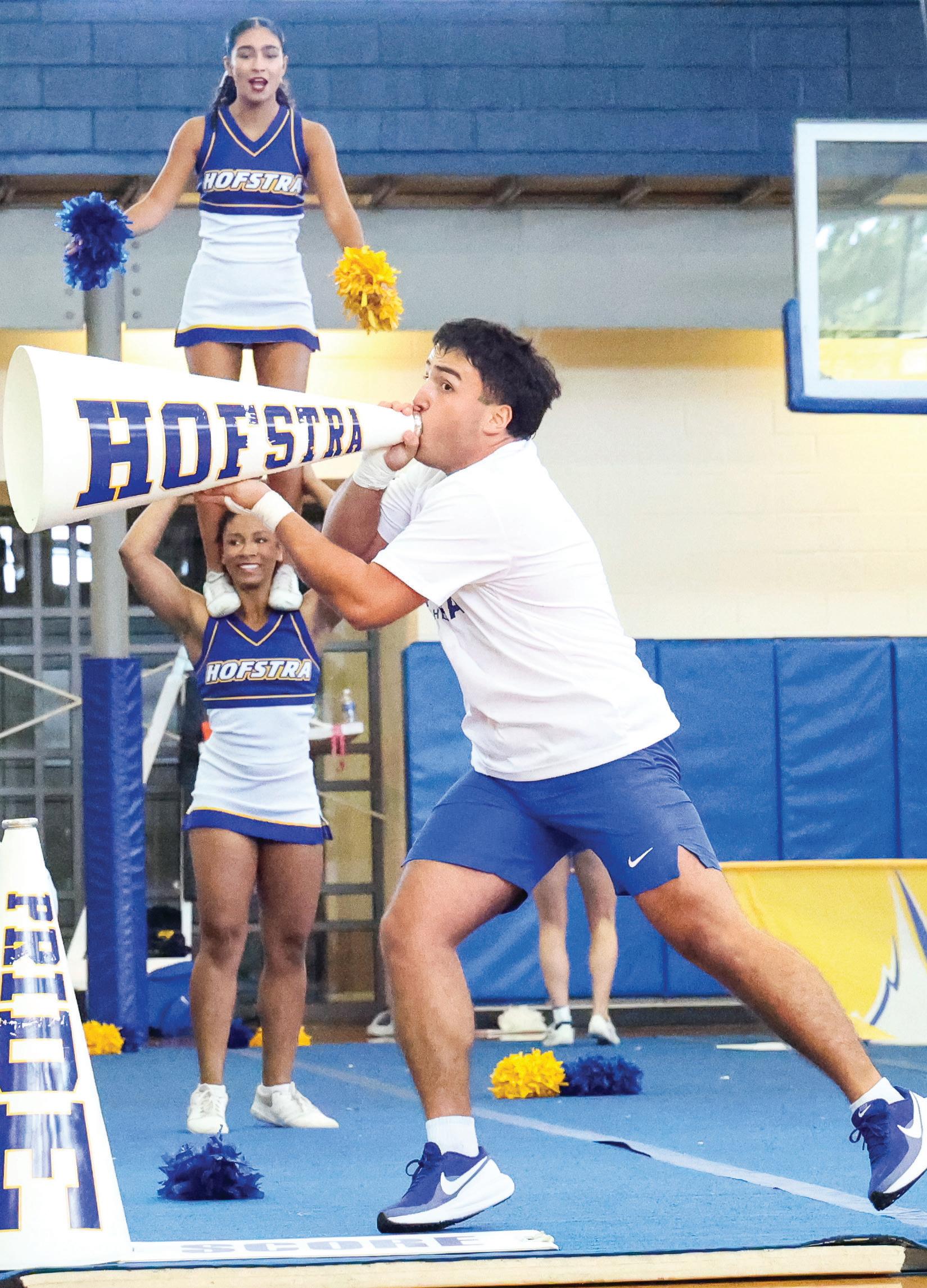
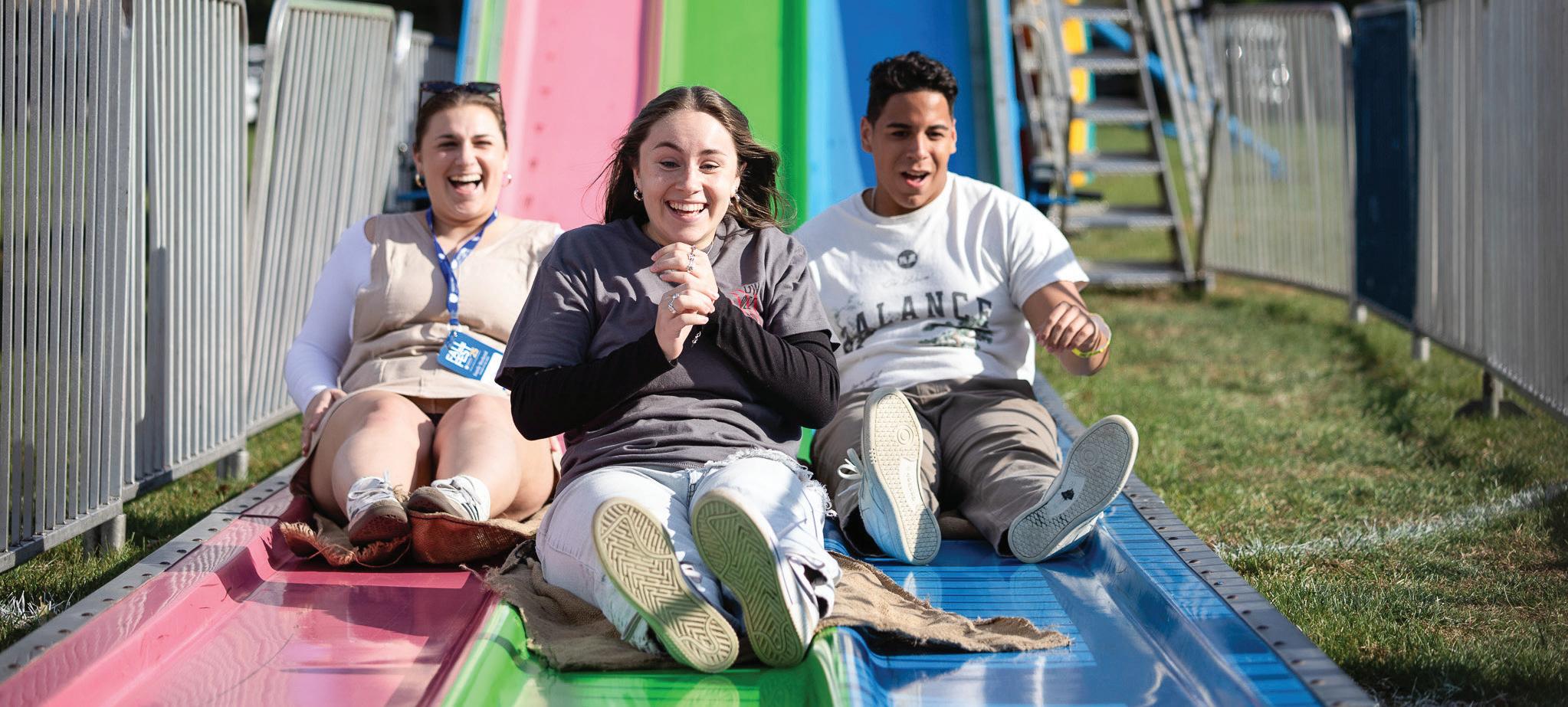
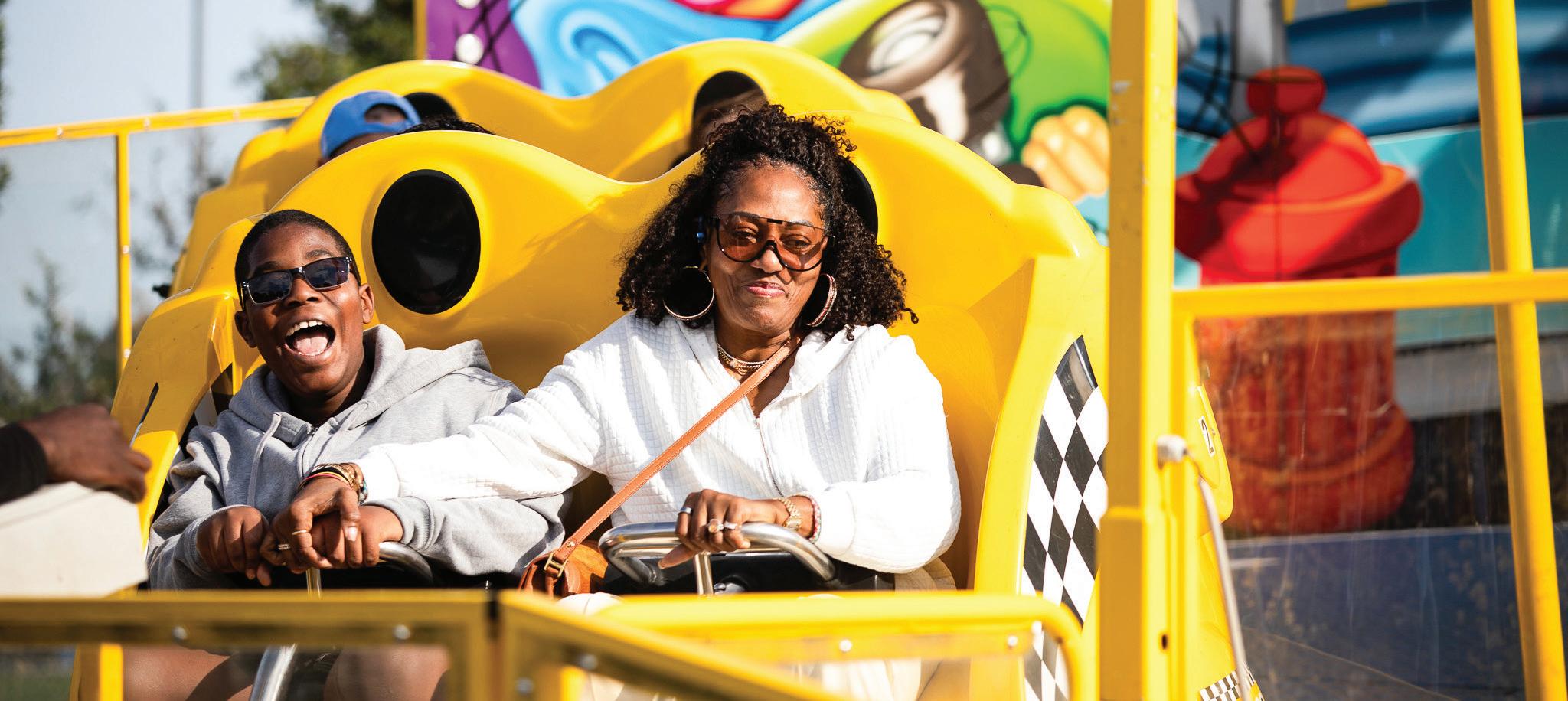

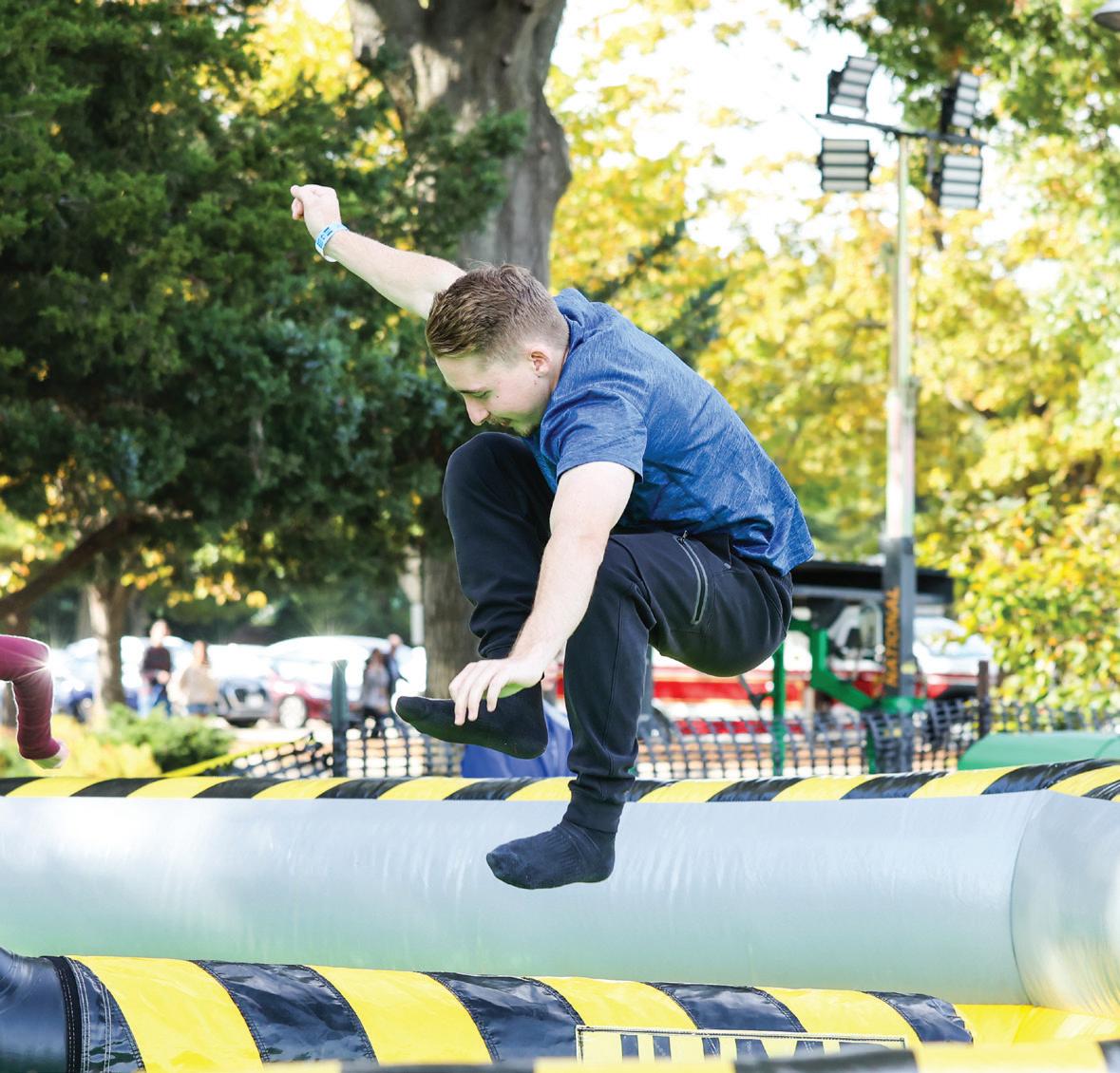

Arts And EntErtAinmEnt

'Peacemaker' ventures into the future of the DCU
By Kimberly Lopez
SPECIAL TO THE CHRONICLE
*SPOILERS AHEAD*
Season 2 of “Peacemaker” premiered on Aug. 21, 2025, with eight weekly episodes releasing on Thursdays. We see Chris Smith (Peacemaker), played by John Cena, endure an emotional self-identity journey and set the stage for what’s next in the DC Universe (DCU). Personally, I adored the more sentimental leaning season, but some audiences felt it left more to be desired.
The first season was heavily praised for being one of the best new generation comic book adaptations and for its ability to make underrated DC characters more prominent. Fans wanted another quirky and action-packed season but instead felt that it was too short and rushed to set up the future of the DCU rather than wrap up Peacemaker’s story correctly.
The second season’s main plot point had to do with an interdi-
mensional portal that lies in Chris’ possession. In one specific reality, all of Chris’ highest fantasies exist: his father and brother are alive, he is treated like a true hero and he has a relationship with Emilia Harcourt. These topics are something Chris constantly struggles to make peace with in his own reality, so it is no surprise when he soon becomes addicted to filling his own shoes in the alternate dimension.
Viewers get a much more emotionally rich and vulnerable look into Peacemaker this season. We see him in a deep depression while being hunted by Rick Flag Sr. His already bruised ego gets more hurt after a failed interview for The Justice Gang. His reality is constantly crumbling around him.
A prominent theme throughout the season is a battle between Chris and self-forgiveness. Chris believes everything is better off without him. He selfishly runs away from his problems, leaving the 11th Street kids behind, with only a letter to explain his official absence into the new dimension,
Earth X.
Cena has certainly earned his acting praise this season. He executes Chris’ depressive tendencies, need for validation and trauma perfectly.
“I really think his performance throughout season two is something just wonderful to behold, and people are going to be completely taken aback from it,” said creator James Gunn via Threads.
Another notable acting highlight comes from Danielle Brooks who, in my opinion, serves as this season’s heart as her character, Leota Adebayo. She grounds Chris constantly, and in an emotional scene in the finale, tells him how loved he is and that if he learns to confide in himself more, he will not feel like such a burden.
During Chris’ time in Earth X, Flag involves himself with Lex Luthor, using his geniuses to track Peacemaker down. Audiences thought this partnership with Luthor felt tacky and was a rushed way to make Flag a larger antagonist. Though the Luthor cameo was thrilling, it focused on setting up the DCU rather than ending the
season properly.
The finale had long-awaited joyous moments for Chris, including becoming a part of Checkmate, entering a relationship with Emilia and accepting his past sins. Unfortunately, it did not last long before Peacemaker was captured by Flag again and put into a dimension called Salvation. It seems this will be a core issue throughout the rest of the DCU and will probably be addressed in the next confirmed Superman movie, “Man of Tomorrow,” which is slated to release on July 9, 2027.
Although fans have expressed their dislike for the season’s conclusion, “Peacemaker” still came a long way. There were things that could have been improved upon – like the episode runtimes and filler moments – but there were still emotionally pivotal moments that were essential to the characters “Peacemaker” has made us love and root for. It is clear Gunn has a new take for this cinematic universe, and only time will tell if he made the right choices.
Is Julia Wolf bringing grunge back to life?
By Cat Pope SPECIAL TO THE CHRONICLE
If you are even half as addicted to your phone as I am, there is a good chance that you have heard the song “In My Room” that has been trending on TikTok. The song is usually paired with an edit of one of the five “Twilight” movies, since those are the artist, Julia Wolf’s, favorite movies. The song went viral online for its 2000s throw-back vibes, and went platinum on my Spotify account. I was utterly obsessed. So, what is grunge? According to my boyfriend and the MerriamWebster dictionary, grunge is a sub-genre of alternative rock. While that may be the dictionary definition, I see grunge as an entire genre of its own – with strong influences from indie, angst, pop-punk, and of course, alternative rock. Artists under the grunge category include Nirvana, Radiohead and slight, subtle hints of Paramore (although, they are
more alternative rock).
Wolf shows tributes to all three bands throughout her new album, “PRESSURE.” Most people say the grunge genre died when the genre’s spearheading artists began releasing less and less music every year. Grunge slowly faded out of radio stations and award shows, only living on through alternative rock bands like Panic! at the Disco, My Chemical Romance and Paramore. When discovering Wolf, you'd have to imagine my surprise, hearing her music sound like all these great bands.
“Grunge is a sub-genre of alternative rock. While that may be the dictionary definition, I see grunge as an entire genre of its own –with strong influences from indie, angst, pop-punk, and of course, alternative rock ”
shows Wolf being suspended mid-air by the skin just below her chest from a harness made from chains. I have fallen so completely in love with the album cover, as it invokes a certain reaction from people. The image is something that clearly couldn’t have been easy to communicate – so far that I admire her vision and ability to story tell.
the self-loathing betrayal she felt after killing it.
While Wolf is not openly religious, she closes the song with a biblical reference to Jesus, and how killing her innocence might’ve made him hate her. She sings, “’Jesus sees, he hates,’ He might hate me.”
Quick Hits


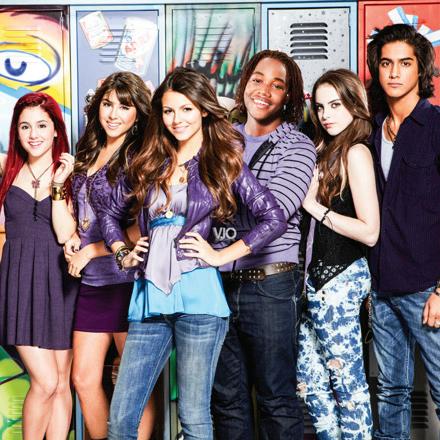
“PRESSURE” is Wolf’s third studio album, and according to global music charts – like Billboard – it’s her best-selling one to date. The album’s cover
The album’s first track, “Kill You Off,” starts the record with an off-beat string of noises, comparable to the opening of Charli xcx’s “Track 10.” The song is seemingly about how she killed off the memory of someone. Yet, after further research and during an interview with EUPHORIA Magazine, she admitted song is about the loss of innocence and
Many may be led to believe the first song is usually somewhat of an outlier, and doesn’t exactly fit in with the other tracks on the album – especially if it’s a title track. If you are one of those people, I have come to tell you that you are totally, completely, wholly and entirely wrong.
My one and only critique is that all her music genuinely sounds the same. It is refreshing to see her sticking true to her genre and what she loves and is clearly good at, but this could also be a very dangerous route to go down when listeners are always looking for something new.
But, I mean, if you like one, you like them all, right?


'Mystery Incorporated:' the best of 'Scooby-Doo'
By Paige Sanacora ARTS & ENTERTAINMENT EDITOR
SPOILERS AHEAD
In September, the “ScoobyDoo” franchise celebrated its 56th anniversary. Spanning 48 films, 14 animated television series, comics, video games and more, the franchise has been a focal point of children’s media since the original show “ScoobyDoo, Where Are You!” first aired in 1969. With few exceptions, most entries into the “ScoobyDoo” franchise focus on the gang solving stand-alone mysteries featuring bad guys in masks, rather than actual supernatural entities, with no overarching plot between episodes and movies. In 2010, Warner Bros. Animation took a notable digression from this historically successful path in the fan-favorite “Scooby-Doo! Mystery Incorporated.”
Everyone has their favorite installments, such as a show from their childhood or a movie that gave them nightmares (you can read about my favorite films on our website). For me, “ScoobyDoo! Mystery Incorporated” is both; while I technically grew up mostly watching the original show and the early 2000s contemporary take on the franchise, “What’s New, Scooby Doo?,” I have watched “Scooby-Doo! Mystery Incorporated” more times than I can count and find it to be the pinnacle of what “Scooby-Doo” has to offer –second only to Jim Stenstrum’s four eerie masterpieces from the late 90s (e.g. “Scooby-Doo on Zombie Island”).
The series establishes Crystal Cove as the gang’s hometown rather than Coolsville from “A Pup Named Scooby-Doo” and James Gunn’s live action films. The town is suspected to be cursed and “The Most Hauntedest Place on Earth,” with the residents, themselves, believing in these supernatural happenings, either through sheer hysteria or to capitalize from touristic opportunities.
Additionally, the town’s history comes with a reoccurring cast of side characters and settings that both help and hinder the gang’s
investigations, including the gang’s own families who desperately want their children to find another hobby. With one or two small exceptions, this is the only time that the “Scooby-Doo” characters have a concrete backstory and hometown that viewers can empathize with.
Since the first episode, “Scooby-Doo! Mystery Incorporated” transcends its predecessors through an over-
nal group, the gang adopts the group’s name and start investigating their sudden disappearance – as two of its members were pictured in the locket.
The series is also renowned for its notably obscure spin on an otherwise cheery franchise. While you certainly will not go more than five minutes without a juvenile quip or out-of-the-box joke, you also cannot assume that everything will ultimately
the entire group, even if it can be downright cringey to watch sometimes. Moreover, it is one of a few times in the franchise that Fred and Daphne are established as a canon couple (which I am a sucker for).
I would be remiss if I neglected to mention the voice talents of the cast. Frank Welker reprised his role as Fred Jones, who he has voiced since 1969 onward, apart from “A Pup
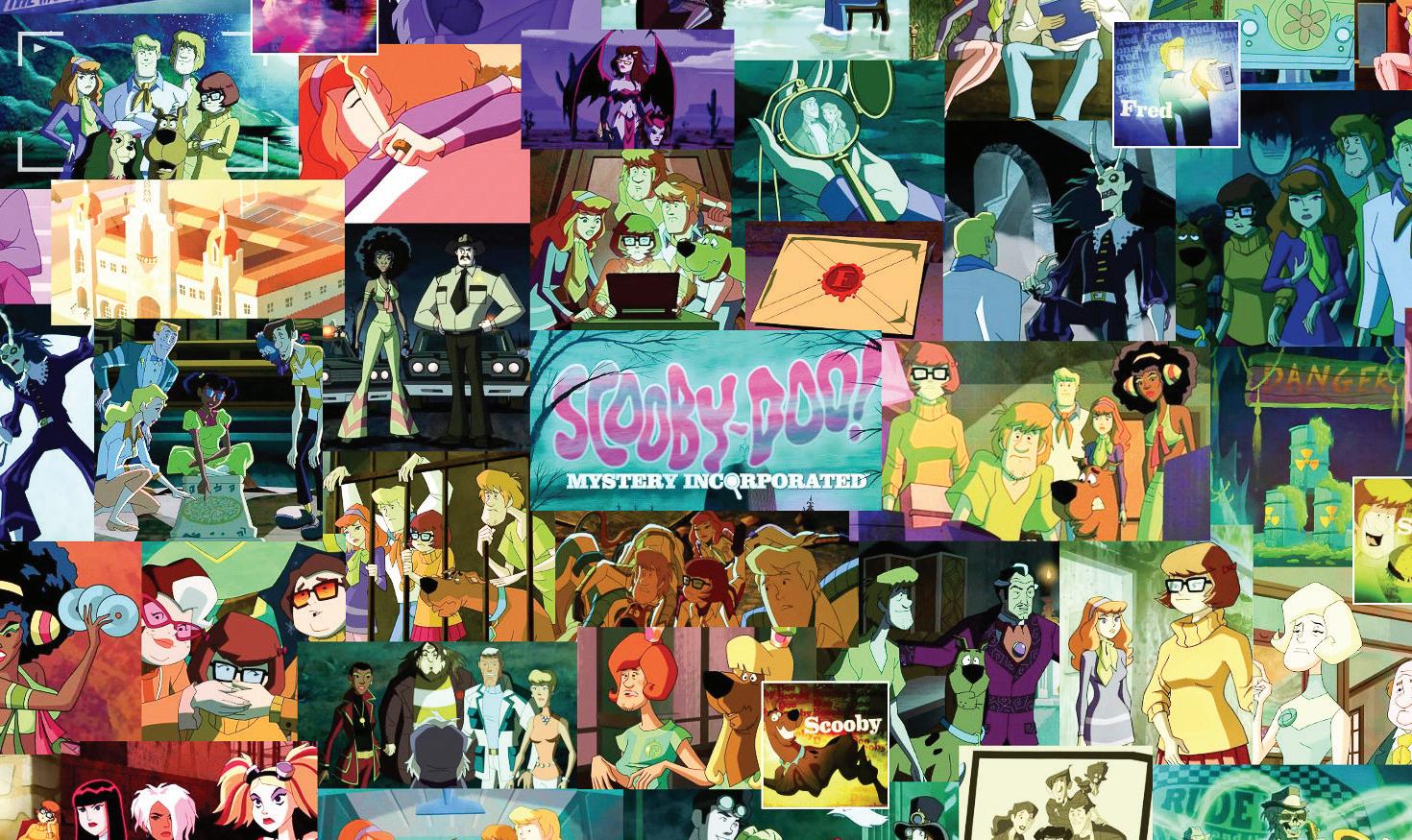
courtesy of Warner Bros.
'Mystery Incorporated' aired 52 episodes across two seasons between April 15, 2010 and April 15, 2013.
arching mystery that the gang can focus on. During their investigation of The Slime Mutant in Episode 1, “Beware the Beast from Below,” Daphne discovers a gold locket with a question mark on it and, inside, a photo of an mysterious young couple. Initially, she assumes the locket was a part of the Mutant’s enigma, until the culprit claims to have never seen it before.
At the end of the episode, they receive a cryptic phone call from a man called Mr. E, who informs the gang that “the real mystery has just begun.”
Even though each episode consists of its own mystery and monster to be explored, occasionally there are new clues which foreshadow to something monumental in the works. The gang learn early on that an earlier team of mystery solvers, known as Mystery Incorporated, vanished without a trace several years ago.
To pay homage to this origi-
turn out positively just because it is “Scooby-Doo.” Throughout the show, themes of violence, manipulation, sacrifice and even death haunt the narrative, especially in the second season. Furthermore, the series tackles important global issues, such as climate change and the dangers of capitalism through overexaggerated and often comedic villain backstories.
Another notable difference this series introduces is internal conflicts within the group. Typically, the only conflicts that the characters face are between the group and the monsters they uncover. In “Scooby-Doo! Mystery Incorporated,” however, the characters struggle with both platonic and romantic conflicts among each other, sometimes causing unstable dynamics or full-fledged fights that last several episodes. I believe that this makes for a more realistic depiction of friendship between
show. Another James Gunn alum, Linda Cardellini, who portrayed Velma, voices a prominent recurring character throughout the series, Hot Dog Water – Marcie Fleach. And that is just to name a few!
Named Scooby-Doo,” “Scoob!” and “Velma” (which he voiced other roles in both projects). Welker also voiced ScoobyDoo, which he has done since 2002.
Grey DeLisle and Mindy Cohn took on their roles of Daphne Blake and Velma Dinkley, respectively, and Matthew Lillard made his animated debut for Shaggy Rogers after playing him in Gunn’s live-action duology.
Prior to Lillard, the primary voice actor for Shaggy was the late Casey Kasem, who cameoed in “Scooby-Doo! Mystery Incorporated” as Shaggy’s father for several episodes.
Other notable cast members include the talented Patrick Warburton who voiced Sheriff Stone. He is known for voicing Kronk in “The Emporer’s New Groove,” among many other projects. Kate Higgins, of “Barbie” and “Monster High” fame, voiced Mayor Nettles in Season 2 of the
“Scooby-Doo! Mystery Incorporated” embraces pop culture of the ages through both subtle and apparent parodies and cameos. In Episode 14 of Season 1, “Mystery Solvers Club State Finals,” Mystery Inc. competes against other detective groups from other Hanna Barbera cartoons that were inspired by “Scooby-Doo.” In one of my favorite episodes from the series, the sidekicks of these groups –Scooby, Jabberjaw, the Funky Phantom, Captain Caveman and Speed Buggy – must work together to find the human members of their groups after a specter leads to their disappearance. In other episodes, cameos of characters – such as BammBamm and Pebbles – can be spotted in the background of scenes, and fan favorites from past instalments also make appearances, such as The Hex Girls and Vincent Van Ghoul. In each episode, cultural parodies, ranging from “The Shining” to “National Lampoon’s Vacation,” are recreated for fans of all genres to enjoy.
“Scooby-Doo! Mystery Incorporated” embodies the essence of what “Scooby-Doo” has to offer. The show was developed through the perfect blend of service to fans and the artistic freedom, which brings something new into an already established franchise. Since the show’s conclusion in 2013, no iteration has successfully recreated what made this adaptation so loved by fans. For instance, “Be Cool, Scooby-Doo!” went too silly, while “Velma” strayed a little too far from the source material. I yearn for the day when a more mature addition to this franchise is attempted again that does not compromise the core of what “Scooby-Doo” was built off of: a group of teenagers and their dog solving mysteries together.
By Frankie DiCalogero EDITOR-AT-LARGE
This year has been a huge year for horror films. One that stood out was “Black Phone 2,” a sequel to the original 2021 film “The Black Phone.” The first installment of the series was well received by critics and crushed the box office, making over $160 million against their budget of under $20 million. While “Black Phone 2” received a higher budget and a bigger rollout, it also had to deal with lofty expectations. Fortunately, these expectations were not just met but shattered, and it became one of my favorite movies this year.
One of the elements that was improved upon from the original film was the suspense. Ethan Hawke once again nailed playing the sadistic role of The Grabber and did not let up in his quest to hurt Finney Blake (Mason Thames) and Gwen Blake (Madeleine McGraw), who believed The Grabber was dead and no longer in their lives. Many times throughout “Black Phone 2,” I got a jolting feeling of worry as The Grabber came close
By Josh Gordon SPECIAL TO THE CHRONICLE
The band Geese has recently experienced a significant surge in both popularity and acclaim. Their most recent album, “Getting Killed,” has been receiving attention across all social media platforms, with many calling it one of the best albums of the year.
Having heard the album myself, I agree with most Geese listeners. The band shares a very fun and energetic feeling through their music that is nothing less than infectious. Its members are Cameron Winter (lead vocalist/ guitarist), Emily Green (guitarist), Dominic DiGesu (bassist) and Max Bassin (drummer). Their natural chemistry is nothing short of magical. Seeing as they have all known each other since high school, that comes as no surprise. Starting in 2016, the band formed and began recording music in the basement of Bassin’s house. Since then, they have
'Black Phone 2' is better than the original
to achieving his goal. Each time, however, the brother-sister duo managed to escape by the skin of their teeth. McGraw’s portrayal of Gwen was strong despite some rocky moments in the script, like the overuse of 80s slang that was too on the nose and cringey. Everything else about the character was great, especially because “Black Phone 2” heavily focused on Gwen, as opposed to the first film, where she was not the main centerpiece. She shined in her expanded role and took some brutal, blood-ridden bumps at the hands of The Grabber. Gwen’s helplessness and fear of what was to come were excellent, and she built an uncanny atmo-
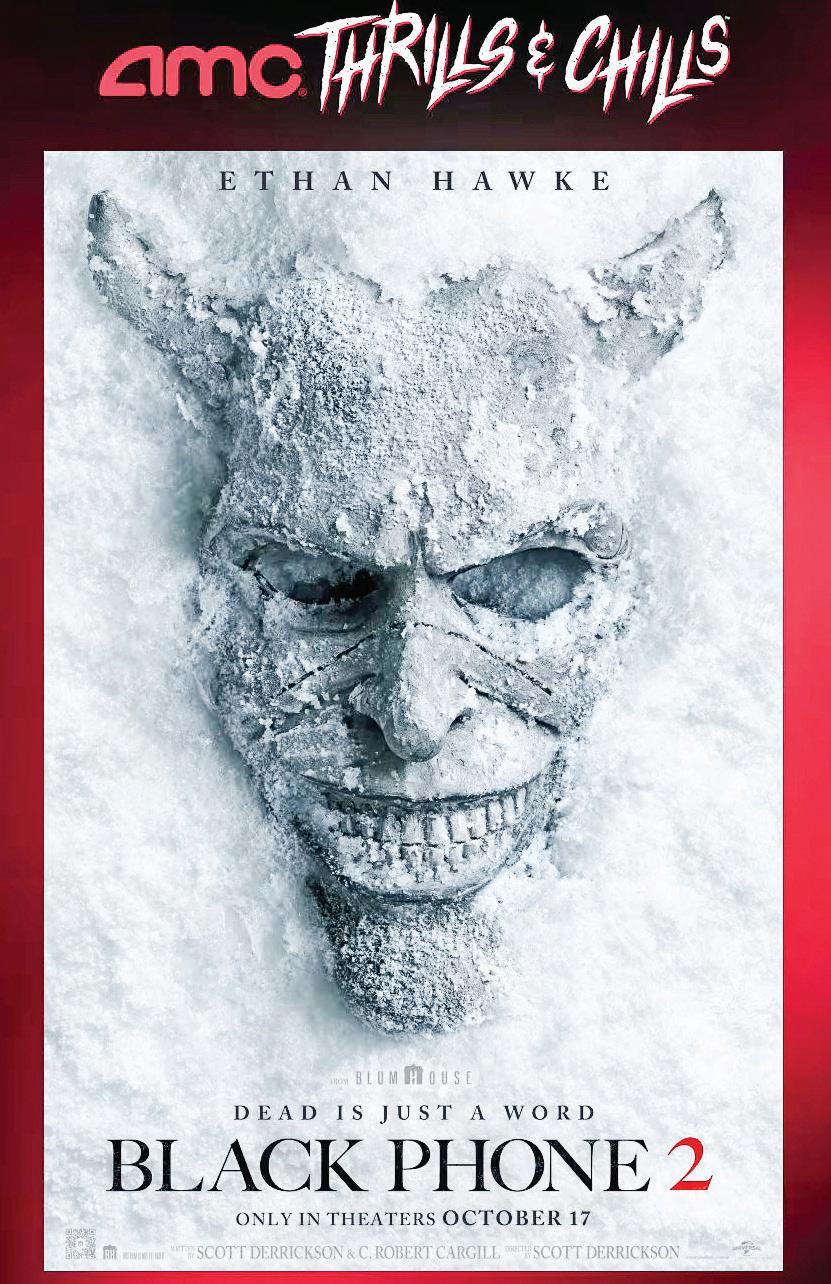
sphere that filled the film and the movie theater. What worked nicely in this movie was the backstory and callbacks to its prequel. It felt like the producers and director took an extensive amount of time to ensure every detail corresponded perfectly, making this movie check all the boxes for a satisfying sequel. For example, it played into the death of Finney and Gwen’s mother.
In one of Gwen’s dreams, she received a call from her mom from 1957 at Alpine Lake Camp. This dream foreshadowed that The Grabber was still alive. Ultimately, the two of them and Ernesto, Gwen’s love interest, traveled to the camp as potential counselors to dis-
Rock band Geese gains traction

reached stardom in close to a decade. Their growing popularity can be partly attributed to Winter, who releases solo music apart from the band. He put out his debut solo album in December of last year, titled “Heavy Metal,” which changed everything. Winter’s solo album was met with widespread acclaim, drawing a large amount of attention to himself and, in turn, to Geese. Because of this, a large part of the band’s fanbase is more than likely
fans of his solo work. Although Winter did contribute to the growing fanbase of Geese, I believe that the band could have eventually reached the popularity that it has now on its own.
On Sept. 27, Geese threw a free concert in their hometown of Greenpoint, Brooklyn, at Banker’s Anchor, and I attended the show with my friend. The entire area was completely packed, and even the street had been blocked off, further show-
cover more about the camp’s history. There, they learned that The Grabber had three more victims who used to go to the camp, and that their bodies were still under ice, giving The Grabber power to reemerge. Gwen also uncovered the truth about her mom’s death, seeing in a dream that it was not a suicide as presumed, but rather a murder at the hands of The Grabber.
“Black Phone 2” throws a lot at its viewers, yet it all makes sense. The film jumps from a static retro feel to a modern-day lens in order to portray the time periods the movie is set in. The cast’s performances, the story’s progression, the gore and violence and the cinematic approach to horror makes “Black Phone 2” a must-watch film. It is different, feels fresh and could be setting up another franchise in horror since interest in a third film has been expressed. Whether that is needed or not is a topic for another day, but for now, “Black Phone 2” did its job effectively.
ing how popular the band is becoming.
There is little-to-no difference in sound between the band’s live and studio versions of their songs. However, the live performance exuded an energy that got the crowd moshing multiple times throughout the nearly 50-minute concert.
Seeing Geese up close made me realize that they were just like me: kids who love music and enjoy what they are doing. It was a beautiful thing to experience. They talked and laughed with the crowd and created a safe space of musical content for the entire duration of the concert.
Their growing popularity has propelled them to television. On Thursday, Oct. 2, they appeared on “Jimmy Kimmel Live!” to perform their song “Taxes” from their new album. They are only furthering their chances on becoming one of the best current rock bands in the world.

The views and opinions expressed in the Opinion section are those of the authors. They are not an endorsement of the views of the Chronicle or its staff. The Chronicle does not discriminate based on the opinions of the authors.
Country music has lost its soul
By Ryan Monke MANAGING EDITOR
Apparently, expressing any type of opinion on political discourse in country music almost automatically gets you labeled as un-American.
In a video shared to Instagram on Tuesday, Oct. 7, country music artist Nate Smith addressed the role of protest in country music. “If you are in country music … and you are anti-American … we don’t want you here,” Smith said. “We don’t want you in our genre. We want you out. Don’t let the door hit you in the a**.”
Smith’s comments seemed to be directed at a preview of country music star Zach Bryan’s upcoming song, “Bad News,” which featured lyrics such as “And ICE is gonna come bust down your door … Kids are all scared and all alone,” ultimately culminating in what the singer lamented as “The fading of the red, white and blue.”
While the song has yet to be
By Tim Daly OPINION EDITOR
officially released, its lyrics have proven controversial enough to warrant responses from those including Smith and even Secretary of Homeland Security Kristi Noem, who stated that the song is “completely disrespectful … not just to law enforcement but to this country.”
These comments about Bryan’s song raise larger questions about what country music is really about.
In the early 19th century, country music was a stage to share songs of economic despair, political frustration and even labor movements. Merle Travis’ “Sixteen Tons” told the tale of the exploitation of coal miners. Bruce Springsteen’s “Born in the U.S.A.,” despite being popular at conservative political rallies, is a protest song about how the U.S. treated veterans of the Vietnam War.
Revered country music icons like Johnny Cash and Waylon Jennings are celebrated for introspective songs often based in the experiences of their politi-
cal landscapes. Cash’s famous “Folsom Prison Blues” takes the perspective of a regretful inmate and advocates for criminal justice reform. Jennings’ “Yoyos, Bozos, Bimbos And Heroes” protests the political circus surrounding the IranContra hearings of the 1980s.
Of course, politically charged country songs were plentiful on both sides of the aisle. What had unified the genre, however, was their practice of not shying away from relevant political and social topics, and instead using their art to express disagreement.
After the Sept. 11, attacks in 2001, country music saw an influx of patriotism. In the wake of the tragedy, many listeners sought out music that fueled their American pride. Some songs spoke to a shared national identity while others aimed to become a rallying cry for Americans and the American military. These patriotic songs spoke to popular sentiments of the country genre, but as country music has become
synonymous with commercialized patriotism, it has shifted away from the outspoken themes of protest that the genre was previously known for. Some songs have been so expressly patriotic and even pro-military that they verge on being outright jingoistic.
Florida Georgia Line’s song “I Love My Country,” features proud lyrics like “Ain’t nothing to be sorry about / I love my country,” while Trace Adkins’ “Still a Soldier,” has lyrics such as “His blood runs red, white and blue / He put away his gun and boots / But he still believes the American dream.” While some ultra-patriotic artists endear themselves to many fans, these lyrics mark a significant departure from the themes that country music was built on.
In the 24 years since 2001, country music has become almost unrecognizable. The shift away from anti-establishment protest songs has largely continued, but now, modern country music is even more superficial. Morgan Wallen – arguably
the face of modern country music – has album after album full of surface-level lyrics about heartbreak and drinking too much. Younger country artists flaunt their partying escapades and lavish lifestyles, while older artists paint pictures of beautiful families living the American dream. A trend of boastful American pride suppresses any substantial social critiques.
Modern day country music is not a monolith. Some artists remain outspoken with songs like Jason Isbell and the 400 Unit’s “White Man’s World” speaking to racial injustices and Sturgill Simpson’s “Call to Arms” chronicling military exploitation by the government. But recent comments that frame political dissent as “un-American” are an affront to the roots of the genre.
Ryan Monke is a senior mass media and political science double major. You can find him on Instagram @rjmonke.
Don’t blame Android for green texts, blame Apple
Making a good first impression is often an immense source of anxiety for those trying to date. If you own an Android, you might be at a significant disadvantage once you exchange numbers and your date sees those dreaded green text bubbles.
In fact, those green messages might even be a deal breaker. A 1000 person survey in 2024 found that 23% of iPhone users said that owning an Android was a dating dealbreaker.
The social pressure to own an iPhone does not just exist in the dating world, the same survey found that 24% of Android users have been left out of group chats for their choice in cellphone. Many Android users face this type of teasing
or exclusionary treatment over their phone choice, which is an overly cruel amount of judgement for a simple purchase. However, what many fail to realize is that this is a symptom of Apple’s anti-competitive features.
Apple encourages this treatment of Android users through their software, with green messages that identify when a text comes from another operating system, or the lowering of photo and video qualities when sent from an Android to an iPhone. Due to Apple’s refusal to fully integrate messaging, iPhone and Android users must deal with technical issues and incompatibility of certain features when messaging crossplatform.
Issues like these are a small part of Apple’s ongoing antitrust lawsuit with the Department of Justice, which alleges
that Apple has a monopoly on cellphones in the United States. Using the tool of social pressure, Apple utilizes these anti-competitive features in order to stifle competition – with control of 58% of the cellphone market in the country. Their intentions are quite obvious too. When someone at a tech conference in 2022 questioned CEO Tim Cook about their inability to send videos with their Android-owning mother, Cook replied, “Buy your mom an iPhone.”
Apple clearly wants the blame shifted onto those who refuse to get an iPhone instead of on Apple for their anti-competitive practices, and sadly, many iPhone users fall for this trick.
Sometimes the hate towards Android users seems simply out of annoyance that texting becomes less convenient.
However, sometimes it is more mean-spirited.
Often Android users are mocked because their phones are seen as cheaper and lower quality, with the camera quality being the target of ridicule.
While this perception of Androids is not necessarily correct – as many models can be just as expensive as iPhones – it is still shocking that many think it is okay to mock somebody for wanting a cheaper phone. Often the line seems to get blurred; are we making fun of someone because their phone is worse or because we think they are “too poor” to buy an iPhone?
Many iPhone users who talk negatively of Android fail to see how its success will benefit them as consumers. When the phone market is not competitive, Apple is allowed to charge unreasonable prices and stagnate in their innovation. If
more people bought Androids and other operating systems, Apple would be more incentivized to improve their products; or at least make them less overpriced. When people pressure others to buy an iPhone, they fall right into Apple’s plan of alienating the users of their competitors, thus harming the consumer’s own leverage as a buyer.
Considering the anti-consumer practices that Apple has been criticized for in the past, such as software updates slowing down their older phones or discouraging people from repairing their products, perhaps a more competitive phone market in the U.S. would further encourage them to win back public trust.
Tim Daly is a senior journalism major and English minor. You can find him on Instagram @timdaly5.

Heavy object that might be found on a desk
"Fine and __!"
Most risqué
"Let's call
OPINION
familiarly
Tears apart
First man
Wine valley in California
"Clueless" lead role
Dr. Seuss's "__ Hears a Who"
Velocity
Eye component 8 Impenetrable haze 9 "Truthfully..." on social media 10 Place on a table, for example 11 Right away! 12 "Catcher in the Rye" protagonist Caulfield 13 Wrestler turned actor Johnson 18 Less narrow 22 Video game venues 24 Expresses approval at a poetry reading, maybe
Sweetie 26 Moon thief, in "Despicable Me" 27 Steal 28 Stretch, with "out" 29 Bicontinental landmass 30 Shimmery finish 33 Speck of land in the water 37 Footballer Manning 38 SNL airer 39 Himalayan ox 41 Grew new biters
42 Chargeable cars, for short
43 Traditional Indian instrument
45 Shredded, as cheese 46 Less difficult
47 Immune system components in the blood
49 Popular California beach
51 "___ a dark and stormy night..."
53 Non-moving
54 Thing
55 Lead-in to girl or boy
56 Volleyball court dividers
57 Small bills
60 Dubai's __ Dhabi
61 Nonverbal approval
The views and opinions expressed in the Opinion section are those of the authors. They are not an endorsement of the views of the Chronicle or its staff. The Chronicle does not discriminate based on the opinions of the authors.
Duo Security is beyond frustrating
By Tom Norman OPINION EDITOR
Duo Security is the worst thing Hofstra University has implemented in the last calendar year, and that is saying something – we have all seen the new Hofstra logo.
The number of times I have been made to look a fool in class because I have to pull out my phone to log into Duo is uncountable, and yet it has not even been in place for a full year. Not only does it make me feel like a jerk for pulling out my phone in academic settings, but it is also just plain annoying.
I would love to hear the very good reason the university has to make
This
my school account more secure than my bank account. Even if someone were to break into my account, what would they do? Change my major? Register me for classes? Obviously, I do not want this to happen, but it was unlikely to happen even before Duo.
Imagine this: you have a class on the third floor of Calkins Hall, and you need to sign in using Duo. Congratulations, you have to either leave the building because there is no cell signal to send you a code or you’ll have to deal with not having a computer for your class. Again, who exactly is this system helping? The fact that you have
is not the
By Matthew Carlinsky SPECIAL TO THE CHRONICLE
When I first heard that Robert F. Kennedy Jr. was claiming that Tylenol was a definite cause of autism, I burst out laughing. It is a claim that is pretty absurd, right? After all, we already know what causes autism: genetics. It was extremely easy for me to brush it off and not think about it much more than that. Then, I came to a dreadful realization: there are people out there who believed RFK Jr.’s claim without hesitation.
It certainly does not help that autism has consistently been in the center of the public’s eye for decades, with sentiments that it is something that needs to be avoided or cured. As someone on the autism spectrum, I can only hope that those who are neurotypical can understand
to sign in using Duo multiple times in a given week is preposterous. If I sign in once and click “Yes, this is my device,” why do I have to do it again a few days later? Why did you even ask if it was my device if you were going to sign me out anyway?
The only thing Duo secures is the biweekly groan it gets from me and my peers when it decides to pop up on our screens to waste our time.
Why are condoms free yet pads are not?
By Cat Pope SPECIAL TO THE CHRONICLE
A friend of mine had recently brought to my attention that Hofstra University gives out free condoms almost everywhere. You can find them at the Wellness and Campus Living Center, upstairs of the Sondra and David S. Mack Student Center and even in some of the resident assistant’s offices. While this is a great practice and incredibly encouraged, why is sexual safety taken more seriously than menstrual safety?
Tom Norman is a senior journalism major. You can find him on Instagram @_tomnorm.
Sure, there are pad and tampon dispensers in some of the women’s and gender neutral restrooms
on campus, but they are most often empty or close to empty. Women can find pads and tampons at one of the two on-campus stores, Dutch Treats or the Netherlands Cafe, for a small price of $6.79. It seems a little backwards to make us pay for products we need for a natural phenomenon we cannot control, but having sex is an choice and we are practically getting condoms thrown at us. I believe the reason that condoms are made more available is because Hofstra does not want any high teen pregnancy or sexually transmitted disease rates attached to the school’s records – as well as valuing reproduc-
tive and sexual safety for all.
But, is my vagina not also a reproductive and sexual organ that needs just as much, if not more, regulation than a penis does? It would be nice to see the change in what is socially recognized as reproductive and sexual health. By making a form of birth control free for thousands of hormonal teenagers and young adults, it gives the illusion that Hofstra is actively encouraging sexual behaviors but not supporting their students’ menstrual health.
Cat Pope is a sophomore writing for the screen major.
attention autism should be getting
how dangerous this kind of rhetoric is. Because of the potential consequences of such statements, it is extremely important to not just bring attention to how we should accommodate those with autism, but to also try and inform a larger audience about what it is as well. In fact, it would be equally as important to have a more accurate, positive representation of autism in television (TV) and movies, too.
Most people have a general idea of what autism looks like in an individual, whether from personal experience or from seeing depictions of it. However, it is easy to forget that it is referred to as a spectrum for a reason – there is no “one size fits all” to whether or not a person has autism.
Unfortunately, this uninformed perspective tends to be at the root of the idea of autism being something to avoid
or cure, or that it is a burden upon themselves and others. There is even a term for this approach to disabilities of any form: it is referred to as a “medical model of disability.” This perspective, even if someone has good intentions, inherently says that those who are disabled – or in this case, have autism – are not normal and need to be changed to be as close to normal as possible. It involves forcing an individual to try and fundamentally change themselves to fit the standards of others, just because of how they were born.
Applied Behavior Analysis (ABA) is a very relevant example of this. According to NeuroClastic, neurotypical people may sing ABA’s praises as an effective tool of helping those with autism adapt to navigating the world. However, autistic individuals
who have gone through ABA have described it to be utterly traumatic.
It is also worth bringing attention to autism representation in media, and the damage that can come from it. The TV show “The Good Doctor” is a prime example of this. Time Magazine points out that the protagonist of the show is a caricature of autism and a collection of autism stereotypes cobbled together. It is easy enough to just write this off as insensitive writing at its worst, until you find out that there are people who believe this to be a genuine portrayal of autism.
I have had my own experiences of people being genuinely surprised to find out I am on the spectrum because I do not act like what they’ve seen on TV. Having these exaggerated, stereotypical representations of autism is
genuinely harmful to those who are on the spectrum, because it is exactly that: a spectrum.
I consider myself to be very fortunate to be on the higher functioning part of the spectrum. I will not beat around the bush either, it can be strange or awkward to interact with those on the spectrum who may require more help to function. But it is especially important to keep in mind that these are still people, with very real thoughts and emotions. We should not be framing them poorly or thinking of them as less than human. Instead, we should be looking for ways to understand and accommodate them in good faith.
Matthew Carlinsky is a senior English major and computer science minor.
Women’s soccer clinches postseason
By Ethan Poole SPORTS EDITOR
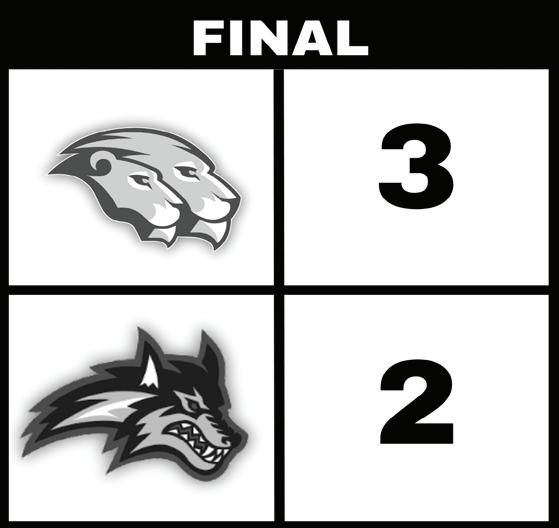
The Hofstra University women’s soccer team clinched a Coastal Athletic Association (CAA) Championship spot with a 3-2 road win over Stony Brook University on Sunday, Oct. 26. The Pride waited until the last day of the regular season to punch their ticket and would have been on the outside looking in without a win.
Hofstra’s offense had sputtered in recent weeks, going 205 minutes without a goal heading into the match. Millie Davies, who was scoreless going into Sunday’s game, changed that. Davies took a free kick from just outside the 18yard box and placed it perfectly, sending the ball above the leaping Seawolves goaltender Jona Hennings and into the top left corner of the net.
The Pride struck again 14 minutes later. Gabriella Marte brought the ball down the left side of the field and uncorked a long pass across the field to Mathilde Braithwaite, who was unmarked and bolting down the right side. Braithwaite headed the ball into the left side of the net and gave the Pride a 2-0 lead, an advantage they took into halftime.
The high-powered Stony Brook offense threatened many
times in the first half, earning four corner kicks and forcing two saves from Pride goalkeeper Lilly Bailey.
The Seawolves, who finished first in the conference in goals scored, did not stay down for long. CAA-points leader Reilly Rich advanced deep into Hofstra’s end but was cornered by Olivia Pearse. Unable to create any space, Rich sent the ball into the six-yard box from the left side of the field. Bailey leapt up but could not corral the shot. The ball went off her fingertips and fell right in front of the net. Stony Brook striker Hannah Maracina picked up the loose change and cut Hofstra’s lead in half.
Just under eight minutes later, Hedvig Helling tied things up. Helling came into the match with seven assists but had yet to score a goal this season. Bailey robbed her in the first half but
was not up to the challenge in the 72nd minute. A Hofstra possession was snuffed out when Marte lost control of the ball and was stripped by the Seawolves. Rich won a footrace with Davies down the right sideline, and play continued despite Davies’ pleas for an out-of-bounds ruling. Rich centered the ball to Helling, who delivered a left-footed finish to tie the game with 17 minutes to go.
Stony Brook’s attack was relentless after the equalizer. Bailey made two saves within two minutes of the goal; the sophomore goalkeeper finished the win with five saves. With the time ticking on the Pride’s season, they began to press. With just over 11 minutes to go, Hennings unleashed a goal kick after stopping a long-range shot from Davies, but the Pride intercepted it.
Davies shielded the ball until Aimee Hodgson became open. Hodgson took a few steps before threading the needle down the right side and finding Pearse. Pearse took the pass in stride before doubling back to give herself space from Stony Brook defender Abigail Roche. With that space, Pearse fired a shot off the crossbar and into the net, sending the Hofstra bench into delirium.
Roche had the only chance to tie the game, sending a free kick into the box, but Bailey dove and smothered the ball, ending the Seawolves’ comeback attempt and securing Hofstra’s ninth consecutive CAA championship appearance.
The Pride and the Seawolves will battle again, but this time both of their seasons are on the line. Kickoff is set for 6 p.m. on Thursday, Oct. 30.
Men’s soccer gets revenge against Monmouth
By Evan Papadopoulos STAFF WRITER

Two goals in as many minutes from Gabriel Pacheco and Laurie Goddard sent the Hofstra University men’s soccer team past Monmouth University in a 4-1 victory on Saturday, Oct. 25. Stefano Campisi and Daniel Burko also added goals for the Pride, and Patrick Osiecki dragged one back for the Hawks.
Monmouth is the only team to defeat the Pride this year in Coastal Athletic Association play with a 1-0 victory at Captains Field in September.
The Pride outshot the Hawks 21-7, with six shots on goal for the Pride and one for Monmouth. Hofstra drew 10 corners compared to
Monmouth’s four, and the Pride committed 18 fouls compared to 10 for the Hawks.
Senior goalkeeper Gino Cervoni made his 12th consecutive start in net for the Pride. He faced just one shot on target and conceded one goal. Freshman goalkeeper Herman Johnsen made his ninth consecutive start for the Hawks. He allowed four goals and made two saves.
The Pride had the first opportunity of the game with less than two minutes gone in the first half, when Campisi earned a free kick in a dangerous position; however, Johnsen punched the ball out to clear the threat.
The Hawks had their next chance when Jasen Bottini took a shot from outside the box that ended up wide of the net.
Hofstra had another opportunity with 15 minutes gone in the first half when Campisi sent a cross to Burko whose header rose over the net to keep the match scoreless.
About 25 minutes into play, Bottini received a straight red card for a challenge on Thengill Orrason, dropping Monmouth down to ten men for the
remaining 65 minutes.
Hofstra took a shot on net with 15 minutes remaining in the first half. Pablo Hempelmann-Perez took a shot that forced Johnsen to make a diving stop to deny the Pride once again.
With about 12 minutes left in the first half, another Hawk found himself in the referee’s book when Erik Annborn received a yellow card for a high boot on HempelmannPerez.
The last 10 minutes of the first half were all Hofstra, but both teams went into halftime tied at 0-0.
The Pride had their first chance of the second half when Johnsen bobbled a shot by Owen Barnett, but Hofstra was not able to take advantage of the opportunity.
Hofstra kept the pressure, and it finally paid off when Campisi played a cross that landed right on the head of Pacheco. The header beat Johnsen and gave the Pride a 1-0 lead for Pacheco’s first goal of the year.
Just a little over two minutes later, Hempelmann-Perez found Burko with a cross, the ball ping-ponged around the six-
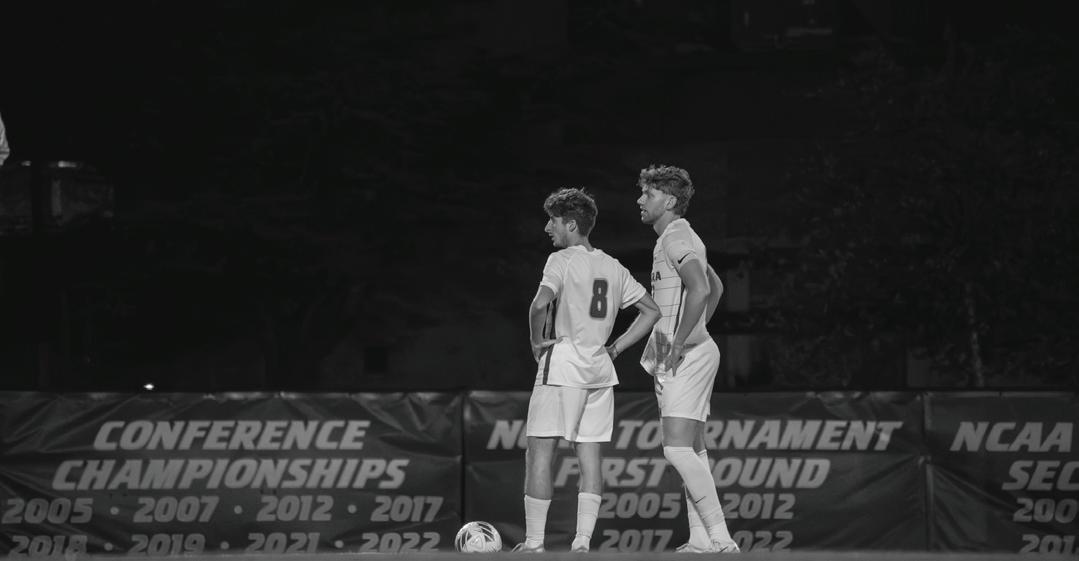
yard box, and Goddard finished the chance with a beautiful outside-of-the-foot shot to double Hofstra’s lead. The goal was Goddard’s 10th of the season, and it extended his point streak to five games. With the goal, Goddard became the first Hofstra player to score doubledigit goals in a season since Ryan Carmichael scored 17 in the 2023 season.
With just over 16 minutes remaining, Burko received the ball from a tackle by Hempelmann-Perez. Burko squared the ball over to Campisi, who beat Johnsen on his near post to add to the Hofstra lead. The goal was Campisi’s first of the season, and his third point on the night.
Monmouth still had fight left in them. Osiecki picked the
pocket of Samuel Francou and took a strike from outside the box that beat Cervoni at his far post.
With about eight minutes left in the game, Aleksei Armas made a tackle on Osiecki, and Armas sent the ball down the wing to Burko, who was oneon-one with Johnsen. Armas beat Johnsen between the legs to put Hofstra up 4-1.
The Pride wrap up their regular season with a home matchup against Drexel University on Saturday, Nov. 1. Kick off from Captains Field is set for 6 p.m.
Volleyball pushes win streak to seven
By Samantha Nadler STAFF WRITER
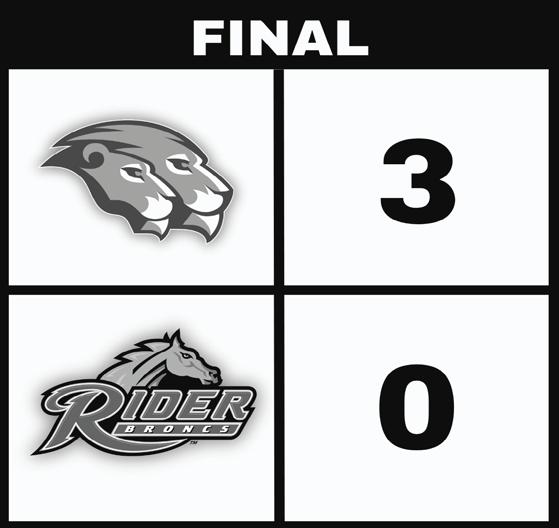
The Hofstra University volleyball team defeated Rider University in a midweek nonconference matchup on Tuesday, Oct. 21, after sweeping them 25-22, 25-9 and 25-14 on the road. The Pride are currently on a 21-set win streak and have swept their opponents in the last seven matches.
Hofstra improved to 16-2 on the season while Rider dropped to 8-12 overall.
Clara Bal led the score for the Pride with 13 kills and a service ace. Izadora Stedile followed
with 11 kills and 10 digs for her 11th double-double of the season. Nina Jioshvili-Ravva led with 38 assists and recorded three service aces. In the back row, Nil Kayaalp led with 15 digs, tying her match-high of the season.
After holding Rider to a 0.097 hitting percentage, the Pride’s defense is still at the top of the NCAA leaderboard with an opponent hitting percentage of 0.099.
Hofstra played a back-andforth opening set, holding the lead until the Broncs started a 4-0 run that favored Rider with a score of 9-7. The Pride regained the lead on a 6-0 run, where Bal scored three kills and Constanza Perez Sain made two of her own. After Jioshvili-Ravva committed a service error, the Broncs regained possession of the lead. The Pride did not find the upper hand until the 20-18 mark. Play then returned to the back-and-forth style that opened the match, but the Pride earned the set point on a kill from Julia
Amorim.
Amorim, who made three blocks on the day, continues to be the NCAA’s third-best middle blocker, averaging 1.71 blocks per set.
The second set was a much more lopsided victory for the Pride, holding the Broncs to a -0.120 hitting percentage. Of Rider’s nine points in the second set, four came from Hofstra errors. The remaining Rider points resulted from Erynn Gotsch and Molly Rohde contributing two kills apiece, while Brynn Johnson tacked on a kill of her own.
Perez Sain also earned all of her team-leading four service aces for the day in the second set.
After an error from Bal gave Rider an early lead in the third set, the Pride went on an 8-0 run, where Bal made two kills and Jioshvili-Ravva made two service aces. The Pride held a substantial lead over the Broncs in the final set, leading by as much as 11 points. The match
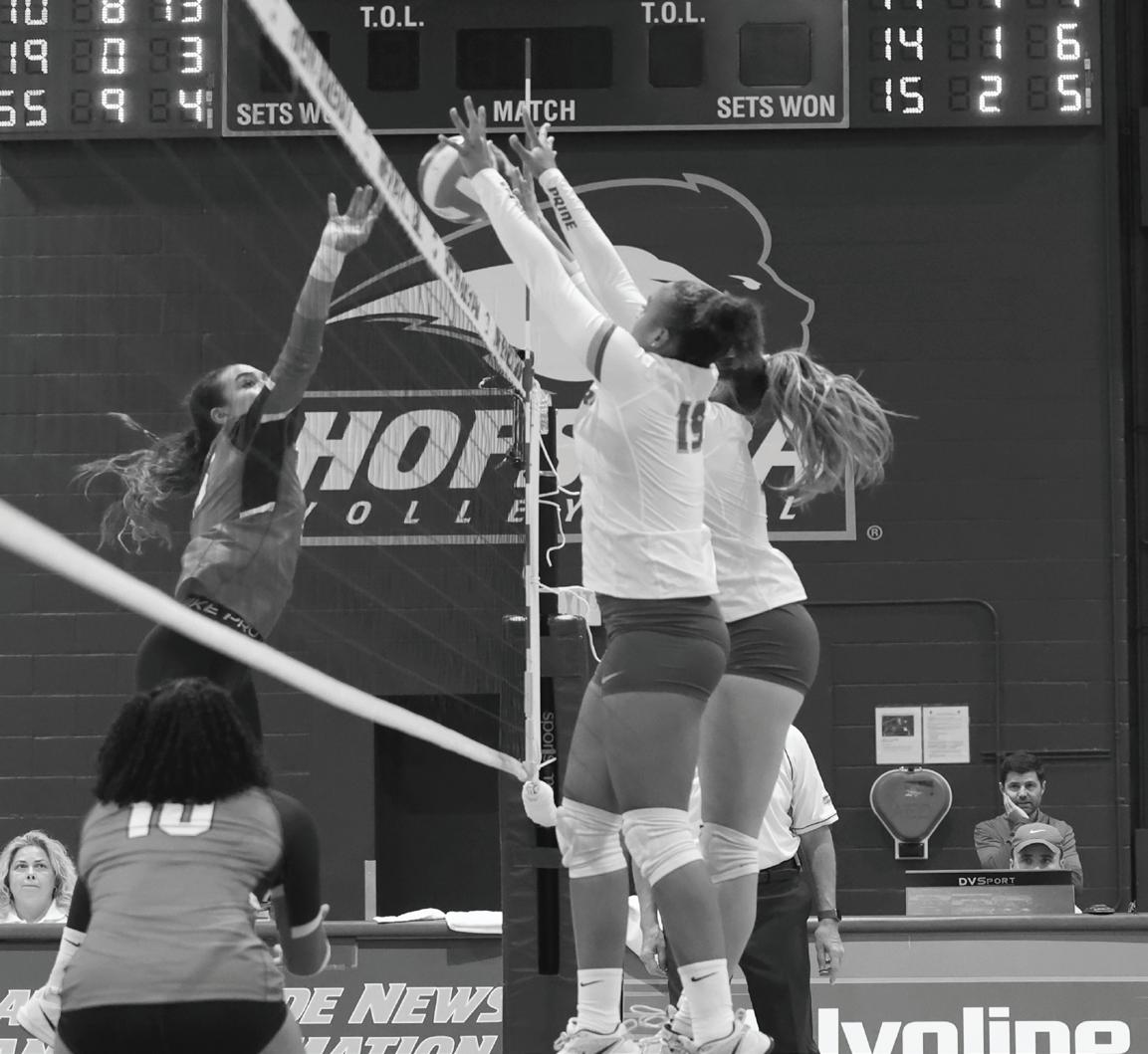
ended when Rider’s Rylah Robinson recorded an error on Perez Sain’s serve, securing Hofstra’s seventh consecutive match win.
After concluding their non-conference play for the season, the Pride now have
the weekend off. They resume play on Saturday, Nov. 1, at North Carolina Agricultural and Technical State University. The first serve is set for 4 p.m.

SPORTS
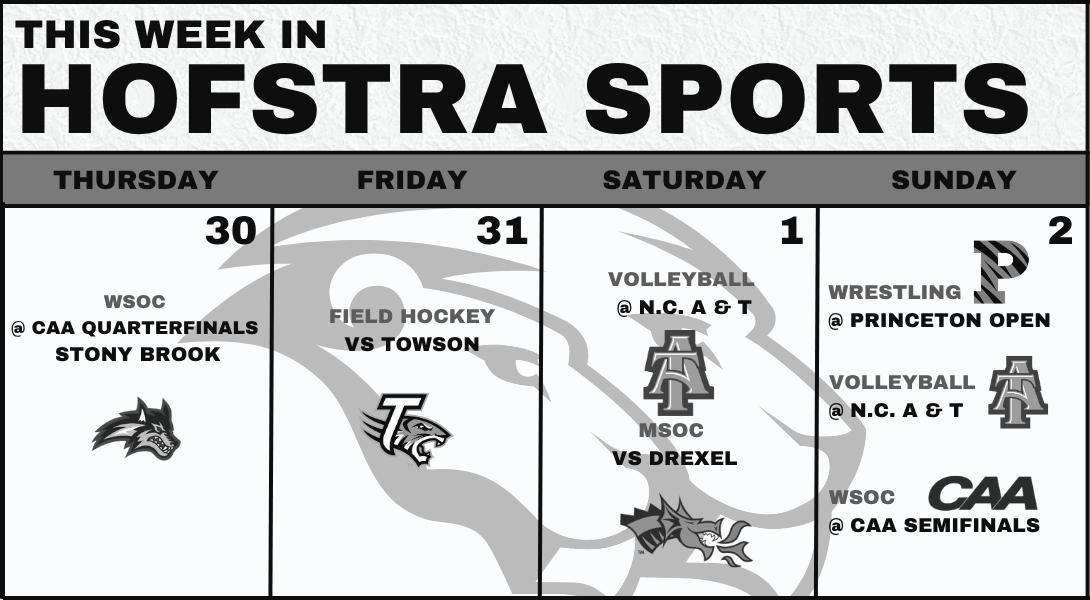
Pride stays in postseason hunt
By Evan Papadopolous STAFF WRITER
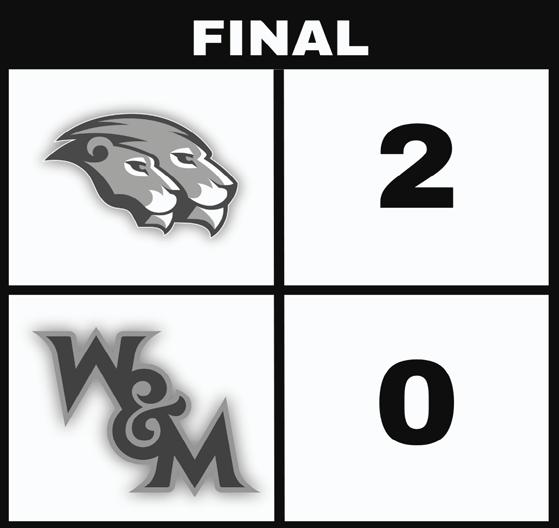
Goals from Kelly Levengood and Jaime Lewis were enough to drive the Hofstra University field hockey team past College of William & Mary in Coastal Athletic Conference (CAA) play on Friday, Oct. 24. The Pride’s victory keeps their CAA Championship hopes alive.
Freshman goalkeeper Luci Hollister got the start for the Pride. She made six saves for a shutout victory.
Junior goalkeeper Alexandra de Jesus started for the Tribe and made twelve saves while allowing two goals.
Hofstra started the game
on the right foot with Pilar Penaloza striking the post and Adrianna Losiak forcing a save from de Jesus less than 90 seconds into the game.
William & Mary would get their first chance of the game from a penalty corner about five and a half minutes into the first quarter. Josie Mae Gruendel inserted, but the Tribe were not able to get a shot on net.
Hofstra started the second quarter almost the same way they started the first, with Lewis forcing de Jesus to make a save less than 30 seconds into the second frame.
The Pride continued putting on the pressure, earning a penalty corner less than two minutes into the second quarter. Teresa Karoff inserted, but the Pride were unable to get a shot off.
William & Mary earned their second penalty corner of the game over five minutes into the second quarter. Gruendel inserted the ball; Lewis blocked a shot from Emme Schwartz and the Tribe earned a second penalty corner. Gruendel
inserted again, and Schwartz forced Hollister to make two saves in quick succession to keep the score tied at zero.
About a minute after William & Mary had their flurry of chances, Hofstra earned a penalty corner of their own. Kristi Santos inserted and the ball found the stick of Jamie Mc Millan, forcing de Jesus to make a kick save.
Hofstra earned another penalty corner about a minute after their previous chance, and Santos inserted again. The ball found the stick of Julia Böcker who passed to Mc Millan. Mc Millan then took a shot that made its way to the endline, but Mackinzie Brown cleared the ball off the line, keeping the Pride scoreless.
Hofstra drew another penalty corner. Santos inserted for the third time, the ball found the stick of Gwenn van Dijk, whose shot forced de Jesus to make a save. As Hofstra retained possession, van Dijk found the ball on her stick and passed it to Levengood, who put the ball past de Jesus, putting the Pride
up 1-0.
Hofstra earned their fifth corner of the quarter about three minutes after scoring.
Kesia Richardson inserted, and the ball found van Dijk’s stick again. She took a shot that de Jesus pushed aside. Mc Millan took two more shots in quick succession, both were shut down by de Jesus.
Hofstra earned a penalty corner about less than two minutes into the second half. Richardson inserted, and the ball found Mc Millan’s stick, forcing de Jesus to make a save.
Mc Millan and Levengood would combine on two more shots that were not able to beat de Jesus.
The final opportunity of the third period came from a William & Mary penalty corner where Gruendel inserted the ball to Amelia Morgan. Morgan’s shot forced Hollister to make a leaping save, and the ball fell to Erin Griffin, who Hollister denied.
The Tribe saw their first opportunity of the fourth quarter on penalty corner. Gruendel
inserted, and the ball landed on the stick of Schwartz, but Hollister made a lunging save to deny the shot.
The Tribe turned the ball over in the penalty circle as Penaloza picked the ball off from an errant touch. She squared the ball over to Lewis who defeated de Jesus in the bottom left corner to double the Pride’s lead.
The Pride finishes up their regular season on Friday, Oct. 31, against Towson University. If the Pride win, they clinch their first top-four finish in the CAA since 2015. Game time from Cindy Lewis Stadium is set for 3 p.m.
A matching set: Nina and Kalli Jioshvili-Ravva
By Samantha Nadler STAFF WRITER
At the 2025 FISU Summer World University Games – a biennial Olympics-like competition for college-aged students, in Rhine-Ruhr, Germany – a set of twins graced the volleyball court for Team France and placed 12th in the 16-team pool. In their last match together, a 3-2 loss to Team Mongolia, Nina Jioshvili-Ravva, a setter, made five assists, while Kalli Jioshvili-Ravva, an outside hitter, earned 19 points. This bittersweet moment would come weeks before the JioshviliRavvas’ volleyball careers took different paths.
“[Nina and I] knew [FISU] was going to be our last tournament before being separated,” Kalli said. “We have a really good relationship, so our last tournament together was really [special].”
For Nina and Kalli, playing volleyball in college was essentially inevitable. The daughters of Victoria Ravva, once a top 100 volleyball player internationally, and Alexander Jioshvili, a professional volleyball player-turned-coach, the Jioshvili-Ravva duo began their own volleyball careers at just four years old.
“I have some memories of playing volleyball with [Kalli] at a very young age with my parents at their gym,” Nina said. “I think [my parents] helped me a lot to understand how to play volleyball and to like volleyball.”
The twins were inseparable on the court, winning France’s
Under-18 championship in 2021-22 and the Under-21 championship in 2024-25 as teammates for RC Cannes –a women’s volleyball club in France. But Division I collegiate volleyball careers separated the duo by just under 2,000 miles. Nina joined Hofstra University’s volleyball team, while Kalli made her way to Texas Tech University’s team. When deciding to bring their volleyball skills to the United States, the Jioshvili-Ravvas considered the warmth of their respective team’s head coaches and their teams’ histories.
“I talked a lot with [Hofstra head coach Emily Mansur], and with our discussion I saw that she trusted me a lot and that she really wanted to work with me,” Nina said. “And our discussion made me realize that [Hofstra] would be a good choice for me.”
“I was interested in coming to the United States,” Kalli said. “When I talked with [Texas Tech head coach Tony Graystone] he told me really good things about Texas Tech, and I feel like he is a really good coach and the volleyball here was really good, so I decided to come [to Texas Tech].”
So far, Kalli has appeared in 18 matches for Texas Tech and started in 11 matches. She leads the Red Raiders with 3.60 points per set and 3.28 kills per set.
Upon arrival to their new teams, there were not many adjustments needed to the Jioshvili-Ravvas’ playing style compared to French volleyball,
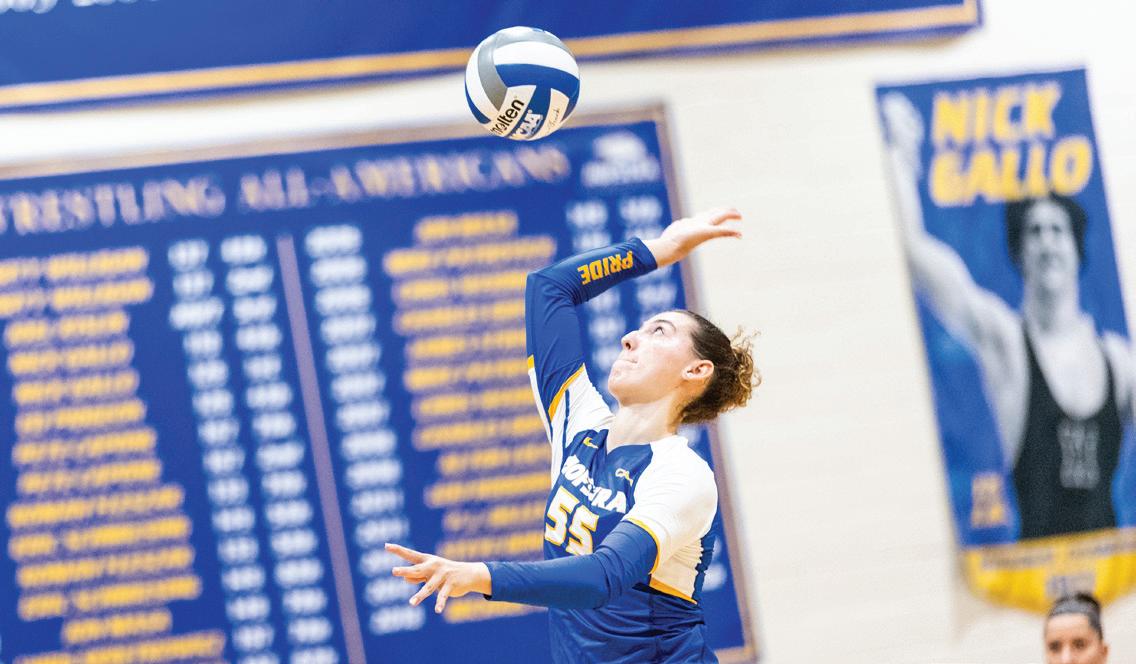
except a more rigid practice regimen and a slightly faster pace of play.
Mansur, who takes pride in her setters, chose Nina as the everyday setter for the 2025 season after the loss of Beatriz Alves, a former Coastal Athletic Association (CAA) Setter of the Year recipient. Upon scouting for potential replacements, Mansur saw something special in Nina’s playing style.
“[Nina] is a pretty mature freshman with the way she plays and the way she carries herself out on the court,” Mansur said. “That’s not something we really get to see from freshmen because they need time to adjust. But she has played at such a high level before she got here that this adjustment has been easier for her.”
Despite being so early in her collegiate career, Nina is excited to use her experience in both indoor volleyball and beach volleyball to be a versatile setter and team player.
“I really love playing beach volleyball,” Nina said. “For a setter … most of the time I’m not spiking balls because my role is just to set up the outside hitters, but because I played a lot of beach volleyball it’s [taught] me how to use these skills on the court as a setter. I can be [closer] to the net and spike balls, but not every setter could do that.”
Mansur praised how Nina has stepped up for her team as one of eight freshmen on Hofstra’s 2025 roster. She is proud of Nina’s mentality in such a highstakes position.
“[I like] just how cool [Nina] is, how chill she is,” Mansur said. “[Whether it’s a] good day, bad day, good match, bad match, she just keeps her composure. As a setter, that’s something so special, and that’s a gift, and it’s amazing.”
Nina is a four-time CAA Rookie of the Week and has won the award for the past three weeks. Nina currently leads the Pride with 628 assists and is ranked in the top 50 setters in the NCAA, averaging 9.81
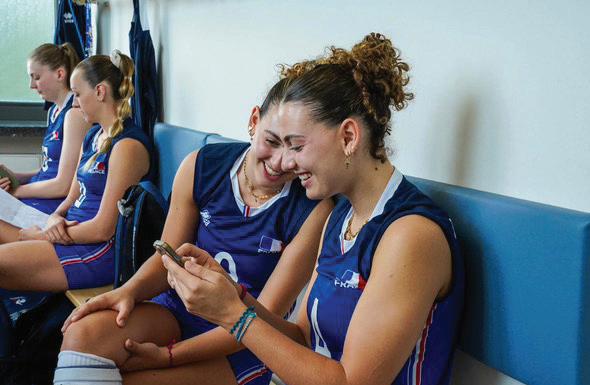
assists per set. She also leads the Pride with 35 service aces and has appeared in every set of Hofstra’s 18 matches.
The Pride’s 7-0 October run, the team’s first perfect month since August 2016, may have been fueled both by team camaraderie and the energy created at Hofstra’s home matches.
“I’ve just enjoyed all the moments with Hofstra [so far],” Nina said. “I really love when all the sports teams come to our games and cheer for us.”
The Hofstra volleyball’s match against Stony Brook University on Friday, Oct. 17, featured athletes from Hofstra’s baseball, softball and wrestling teams cheering for the volleyball team. The wrestlers arrived with a ski-masked bodysuit in a singlet and the words “Block Party” spelled across 10 wrestlers’ chests. Hofstra’s athletes, including Nina, can agree that this type of support elevates the energy on gameday.
While the Jioshvili-Ravva twins are separated by 2,000 miles and a time zone, they still manage to stay connected with each other.
“I miss [Kalli],” Nina said. “She’s my sister and we’re always together, like alwaysalways, but we’re still talking a lot about what’s happening [at Hofstra] and what’s happening at [Texas Tech], just to know about each other and the team.”
“We’re texting all the time,” Kalli said. “We’re calling like
every night; we’re talking every day. But yeah, I think we’re still connected.”
There is an excitement among both Nina and Kalli of returning to France and playing as teammates over the summer. While a reunion will not be until after another semester, being teammates again is something the Jioshvili-Ravvas are looking forward to.
“When we play together – I think it’s because we’re twins and we’re very close – we have some days where we play really well together, and I really love playing with her,” Nina said. “I know everything about her, and she knows everything about me, so we knew how to play together. I know her [off] the court too, so we have this connection that I can’t have with anyone else because we’re sisters.”
“I know that we can play together again on the national team, so it’s okay,” Kalli said. “But it’s a little hard to play without her now.”
By Ethan Poole SPORTS EDITOR
Hofstra University men’s and women’s soccer head coaches
Richard Nuttall and Simon Riddiough have established a culture of excellence around the soccer program. Combined, the two coaches have 15 conference championships and 585 total wins, including 11 in the NCAA tournament. Nuttall’s 37 years coaching the men’s team and Riddiough’s 20 seasons at the helm of the women’s side have seen some of the greatest moments in Hofstra Athletics history. However, as Nuttall reaches the end of his unmatched coaching career, he and Riddiough are more sentimental about their relationship than the trophies on their shelves.
When Nuttall made a recruiting trip to England in 1990, Riddiough was not on his radar, but a standout performance quickly changed that.
“The college he went to was a very good soccer-playing team,” Nuttall said. “I went to watch two of their other players, but when I was watching the game, I saw this guy flying up and down the left side of the field … I said, ‘God, he’s not bad, he’s tough.’ After the game, I spoke to the coach about the other two,
From player to peer: Riddiough and Nuttall
and I said, ‘What about your left wingback?’ … He was the kind of player we wanted: tough, hardworking and motivated.”
For Riddiough, meeting Nuttall and eventually coming to Hofstra marked a new beginning.
“I loved my four and a half years at Hofstra,” Riddiough said. “They were the best [years] of my life, on and off the field.”
The relationship between player and coach was a close one.
“My parents made me come to America, and since then, [Nuttall has] always looked after me; he always got me summer jobs, training and coaching,” Riddiough said. “I loved playing for him, we’d run through a brick wall for him.”
Even as a player, Riddiough was a standard-bearer for the Pride on and off the pitch.
“He played for five years, he got injured one year and was captain the other four years, he might be the only person I’ve ever had who’s been captain for four years,” Nuttall said. “He’ll be the first to admit he’s not the smoothest or the most skillful, but he’s the toughest, the quickest and the hardest. He used to give every ounce of his energy to the game … I think I played him just about every

position on the field.”
Riddiough earned the respect of his players and coaches not just with his tenacity on the field, but with his demeanor in the locker room and in practice.
“His leadership was real, honest and open. He’d hold people accountable. [Riddiough was] not a screamer or shouter or demeaning, but he was a loud, direct person who exuded confidence himself,” Nuttall said. “Nobody worked harder than him or gave more than him, so everybody respected him. Whatever [Riddiough] said, the rest of the group fell into line. He was a leader by example.”
After Riddiough graduated and became an assistant coach for the women’s soccer team, the pair became close friends.
“We were always in touch; it’s become a never-ending relationship,” Nuttall said.
“We’ve done a lot together over the years,” Riddiough said. “We’ve been involved on and off the field for many years. I was his daughter’s godfather, and he was in my wedding party.”
Both men have gone through ups and downs together, with some moments standing above the rest.
“I’ve got 1,000 great stories, but I’m not sure I can share them,” Riddiough chuckled.
“We’ve gone through a lot of good, bad, ugly and excellent times. We’ve partied together, we’ve been to bachelor parties together, we’ve cleaned houses together and we’ve done gardens together. There’s nothing that me and [Nuttall] haven’t shared. We’ve had some fantastic times and great laughs.”
Riddiough was an assistant coach from 1996 to 2005, when he took over head coaching duties from program founder JoAnne Russell.
“He was the assistant for many years, and he deserved the head coach’s role,” Nuttall said. “A major part of [Russell’s] success, which she will admit, was having [Riddiough] as an assistant.”

As a new head coach, Riddiough took lessons and inspiration from many different coaches, including Nuttall.
“[Nuttall’s] strength is always his motivation, his caring, his empathy and his love for his players,” Riddiough said. “He was always an effective coach tactically and had an ideology he trusted and believed in. I think it’s valuable as a young coach to understand that and appreciate that. He also took extra time to care about each and every player. Hopefully that’s something that my players would agree with, that I do take a vested interest in them, not just as soccer players but as people.”
As for Nuttall, even the elder statesman of Hofstra soccer learned a thing or two from his former player.
“I honestly think he’s more detail-oriented than me,” Nuttall said. “We can learn from him. He really gets granular with what he does with the girls, and I think he understands the game really well.”
Even though Nuttall and Riddiough coach for different teams, every victory for either team is a victory for the whole soccer program.
“I felt [like] a part of all his success, and I’m sure he felt [like] a part of our conference titles and wins as well,” Nuttall said.
Nuttall and Riddiough come from nearby areas of England.
“Our town is a rough town,”
Nuttall said. “I’m proud of what he’s done, and I’m proud of what I’ve done. It’s nice to see a success story.”
With Nuttall’s career winding down, Riddiough is soon to be the figurehead of Hofstra soccer, but his gratitude and love for his former coach knows no bounds.
“There’s a deep love and a deep gratefulness for him more than anything else,” Riddiough said. “In the early days, he was almost like a big brother figure for me. Coming from England as an 18-year-old, you get homesick and need a lot of support, and he was there for me. He got me involved in a local club, which I’ve been a part of since coming to America. I played for him in the semi-pro league, I’ve coached with him everywhere he’s gone … I’ve been very fortunate that he’s always embraced me and allowed me to work for him and with him. For that, you’ve got to have sincere gratitude, and that’s what I have for [Nuttall], it’s true gratitude for what he’s done for me and my friends, and what he did for Hofstra and the program.”
Nuttall will not be departing Hofstra upon his retirement. He will be taking the role of Assistant Director of Athletics for Development and Alumni Affairs, while Riddiough is expected to remain the coach of women’s soccer for years to come.
THE HOFSTRA CHRONICLE
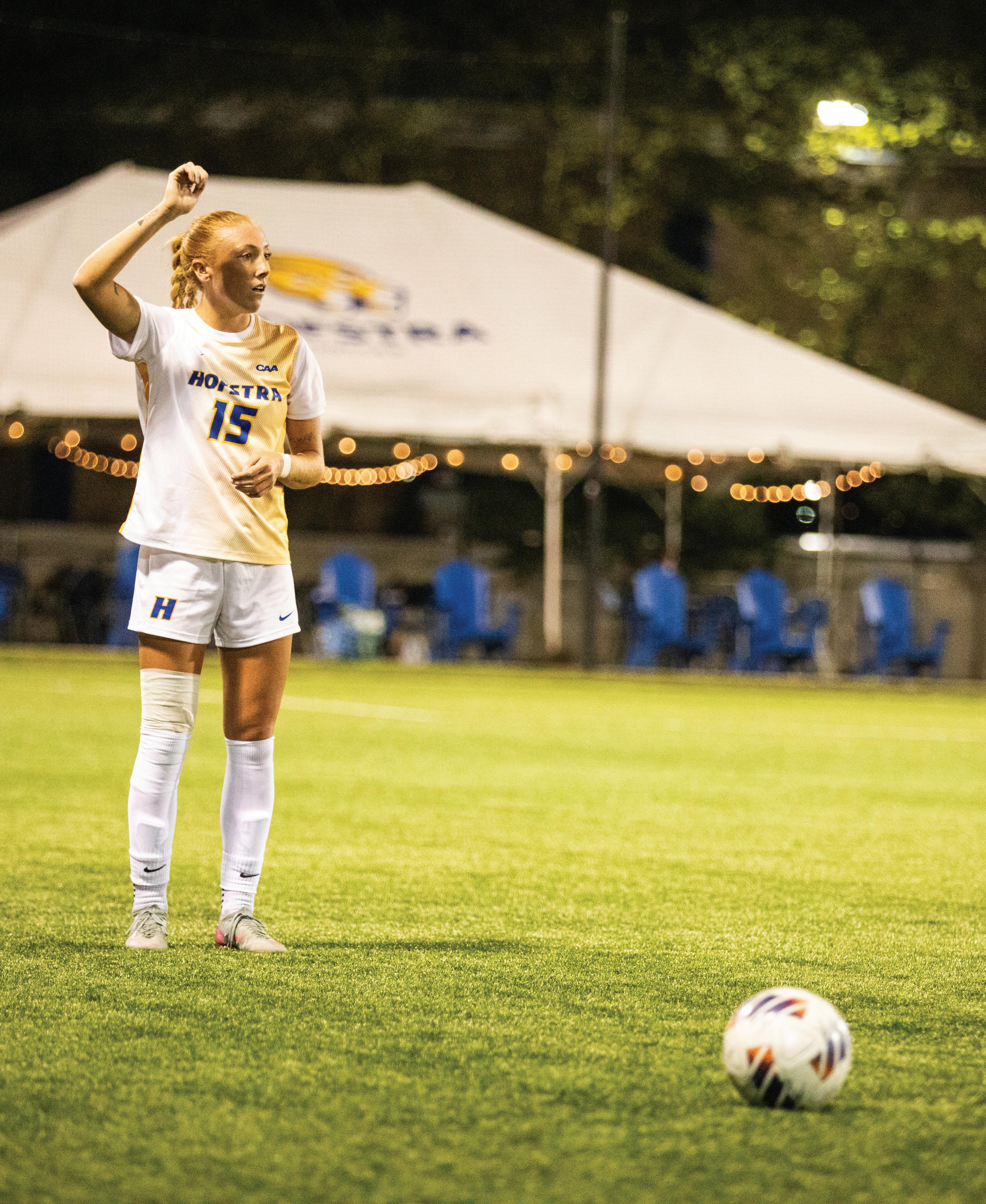
October 28, 2025
W ho clinched playoffs ?
Olivia Pearse and the Pride did! Her game-winning goal pushed Hofstra over Stony Brook University.
